Combarro to Sanxenxo
30/May/2007 18:07 Filed in: Ria de Pontevedra
Quite a bouncy night last night and I didn't get all that much sleep. We were anchored in water ranging in depth from 2.5 to 4.8 metres with winds from the SW up to F5 with a longish fetch.
No problems but I didn't want to spend another night off Combarro. We seem to be in a Navtex blackspot an so are not getting our normal weather forecasts. The morning radio forecast for Finisterre is predicting SW 5-7 so I decided to go back to Sanxenxo.
We weigh anchor at 11:00 and are all fast in a visitor berth at Sanxenxo marina at 13:45. I had expected this to be an expensive marina but high season starts on Friday so the daily cost now is €9.34. On Friday it will triple.
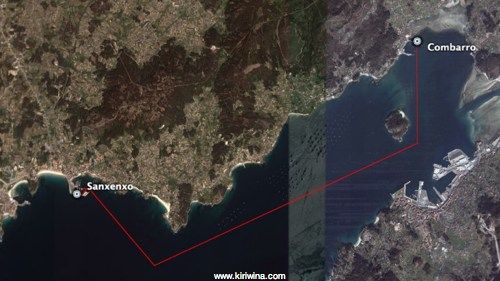
No problems but I didn't want to spend another night off Combarro. We seem to be in a Navtex blackspot an so are not getting our normal weather forecasts. The morning radio forecast for Finisterre is predicting SW 5-7 so I decided to go back to Sanxenxo.
We weigh anchor at 11:00 and are all fast in a visitor berth at Sanxenxo marina at 13:45. I had expected this to be an expensive marina but high season starts on Friday so the daily cost now is €9.34. On Friday it will triple.

Sanxenxno to Combarro
29/May/2007 10:36 Filed in: Ria de Pontevedra
Woke up at 05:00 with the boat bouncing in short choppy seas blown up by and overnight F4-5 southwesterly. Checked the position and our anchor was holding just fine but it was not a good place to be with that wind.
After getting Kiriwini aboard we weighed anchor at 07:00. I had decided to move up the Ria to Aguete which was well spoken of in both pilot books.
Unfortunately when we got there at 09:00 the pontoons were derelict and clearly not in use. After 15 minutes we left and set off for Combarro where we anchored at 10:25 in rainy unsettled weather.
Lighthouse on Isla Tambo, Ria de Pontavedra.
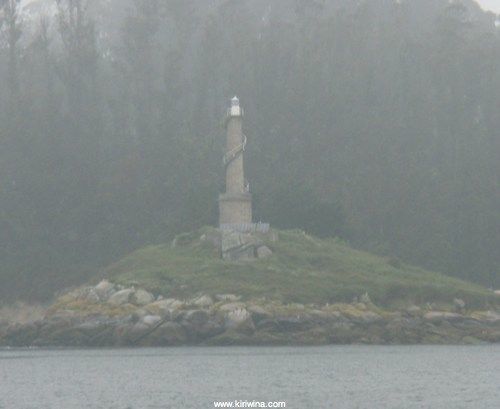
Combarro Village with low lying cloud.
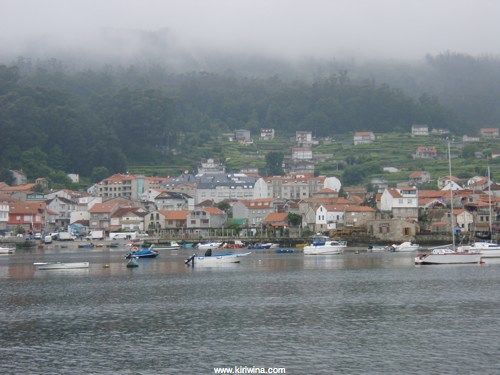
For much of the day it continued to rain with variable gusting winds. At around 19:00 the rain stopped and I was able to row ashore for a look around Combarro. It is a small fishing village which is something of a tourist attraction because of a small labyrinthine section of traditional Galician stone fisherman's houses.
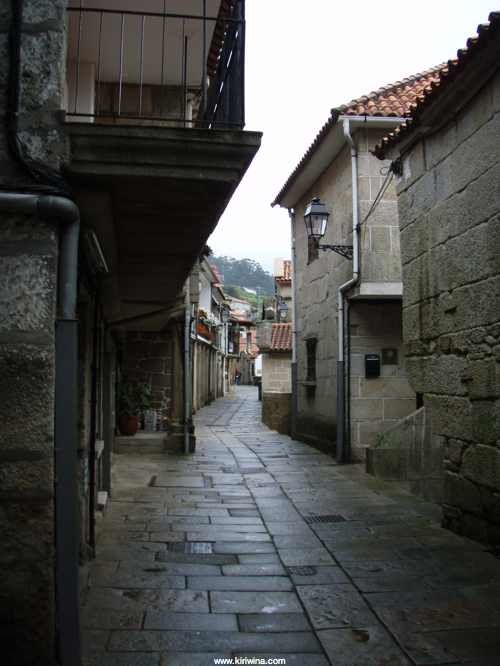
Waterfront in Combarro with a lot of Horreos. These are found all over Galicia, usually stone built and used to store agricultural produce. They are built on stilts and the discs or mushrooms between the Horreo and the stilts are to stop rats getting inside.
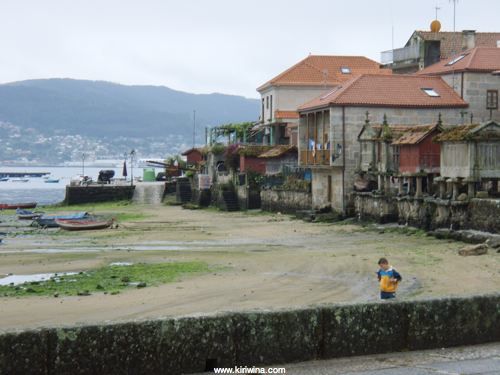
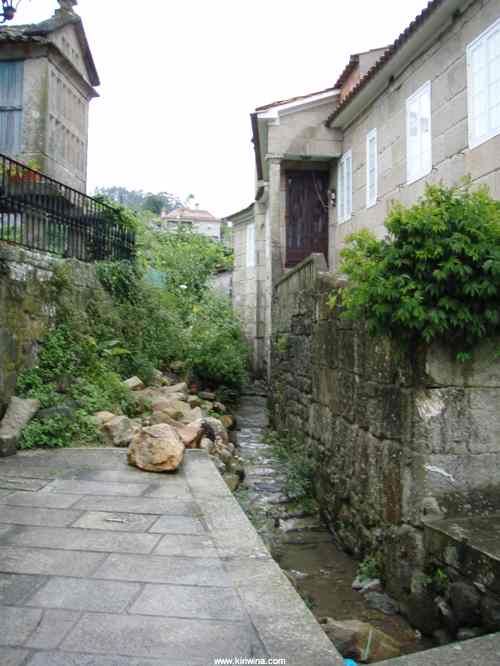
It is very pretty and many of the houses have been restored, others are being restored and the rest probably will be. How long they will remain houses for local fisherman remains to be seen. A small marina is being built with a development of modern apartments near the harbour. Already at least 8 of the old houses have become t-shirt/souvenir shops and I noticed at least 5 newly restored houses for rent.
Would benefit from some modernisation...
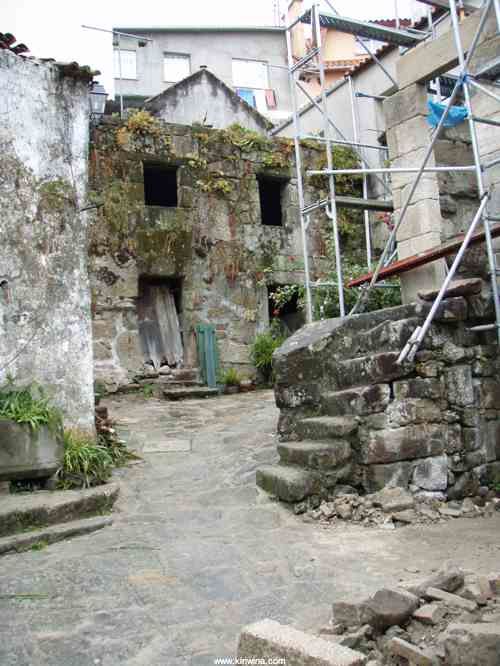
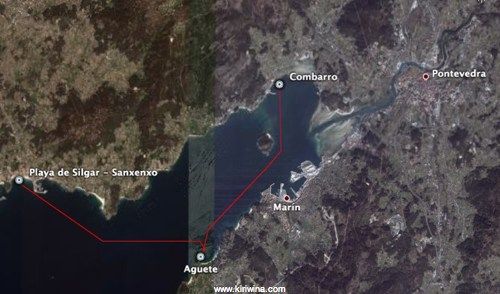
After getting Kiriwini aboard we weighed anchor at 07:00. I had decided to move up the Ria to Aguete which was well spoken of in both pilot books.
Unfortunately when we got there at 09:00 the pontoons were derelict and clearly not in use. After 15 minutes we left and set off for Combarro where we anchored at 10:25 in rainy unsettled weather.
Lighthouse on Isla Tambo, Ria de Pontavedra.

Combarro Village with low lying cloud.

For much of the day it continued to rain with variable gusting winds. At around 19:00 the rain stopped and I was able to row ashore for a look around Combarro. It is a small fishing village which is something of a tourist attraction because of a small labyrinthine section of traditional Galician stone fisherman's houses.

Waterfront in Combarro with a lot of Horreos. These are found all over Galicia, usually stone built and used to store agricultural produce. They are built on stilts and the discs or mushrooms between the Horreo and the stilts are to stop rats getting inside.


It is very pretty and many of the houses have been restored, others are being restored and the rest probably will be. How long they will remain houses for local fisherman remains to be seen. A small marina is being built with a development of modern apartments near the harbour. Already at least 8 of the old houses have become t-shirt/souvenir shops and I noticed at least 5 newly restored houses for rent.
Would benefit from some modernisation...


Puerto Piedras Negras to Sanxenxo via Isla de Ons
28/May/2007 17:39 Filed in: Ria de Pontevedra
After breakfast we left Puero Piedras Negras at 10:35 bound for Isla de Ons. There was not much wind and we sailed slowly south gradually gaining speed as the morning wore on.
At 12:10 we passed the northern end of Isla Ons and anchored off Playa de Melide at 12:50. What a lovely spot.
At anchor off Playa de Melide, Isla de Ons
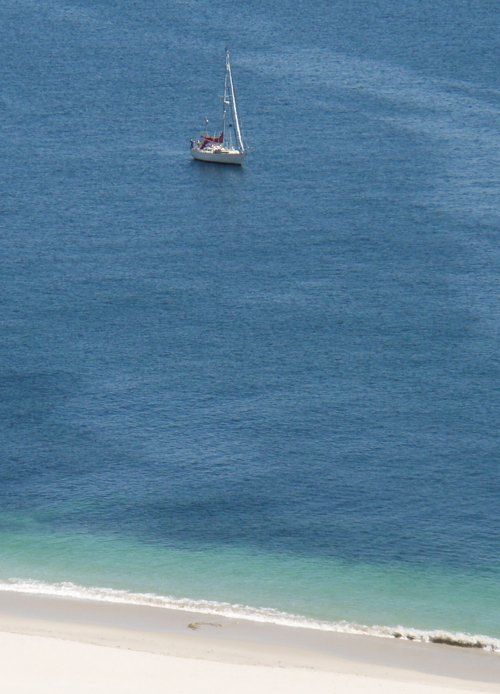
I rowed ashore in Kiriwini. The beach was deserted apart from one couple at the far end. The water was clear, the sand soft and warm underfoot just lovely.
A path led up and away from the beach through a forest of gum trees. It could easily have been in Australia.
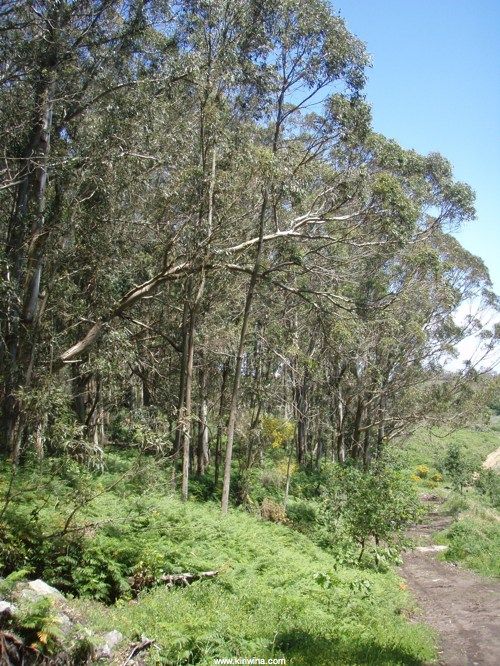
The east coast is less harsh and far more verdant with woods of pine or eucaluptus
Looking south along the east coast with the only jetty in the distance.
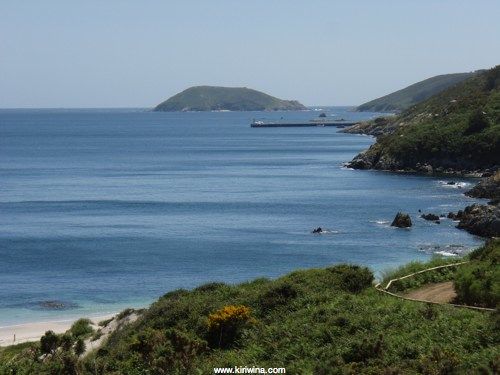
The west coast is exposed to the full wrath of the atlantic. No beaches or trees here, just harsh jagged rocks and stumpy bushes.
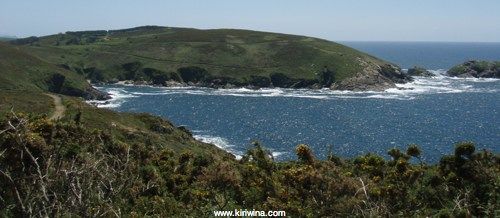
A sailors memorial, typical of many on this coast. This one was to Anxo who was lost at sea aged only 22.
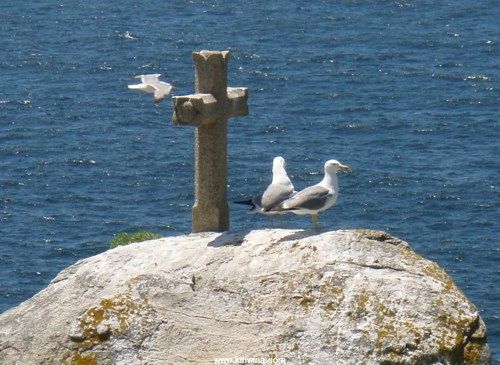
Vegetation found on the west coast. These plants are about 2-3 feet tall and are a little inland of the coast.
Those closer to the cliffs are only around 6" tall.
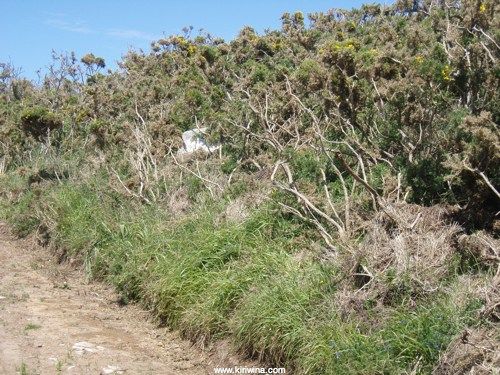
The lighthouse at the island's summit. A new slate paved road was being built to it leading up from the jetty.
There was also a helicopter pad and two banks of solar panels to provide some of the power.
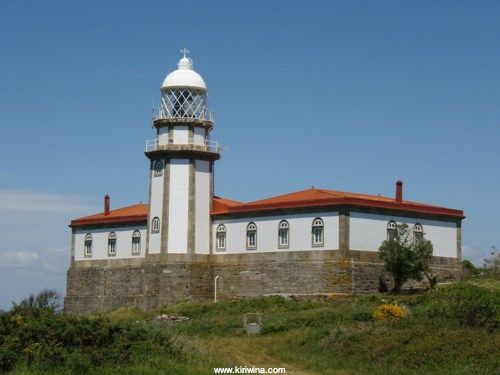
I got blisters after walking most of the way round Isla de Ons. A really enjoyable stop.
We weighed anchor at 16:55 and sailed over to Playa de Silgar just west of the large marina at Sanxenxo where we anchored at 19:05.
Sculpture on a rock off Playa de Silgar
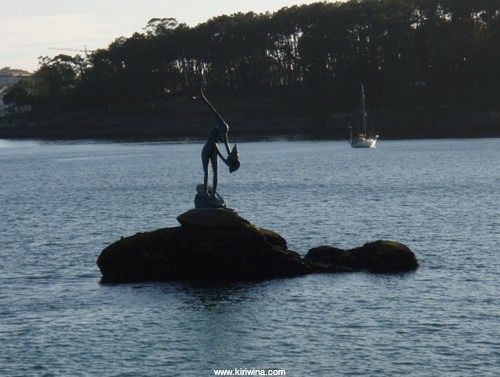
Sanxenxo is a largish visually challenged holiday town with a huge modern marina. I rowed ashore landing on the gently shelving Playa de Silgar for a walk around.
A Canadian yacht built in 1980 by it's owner who has been wandering around the world ever since. we were later to moor at the same dock.
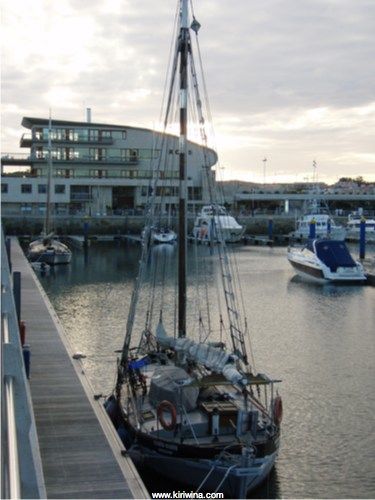
Late evening, Playa de Silgar. It wasn't so tranquil the following morning.
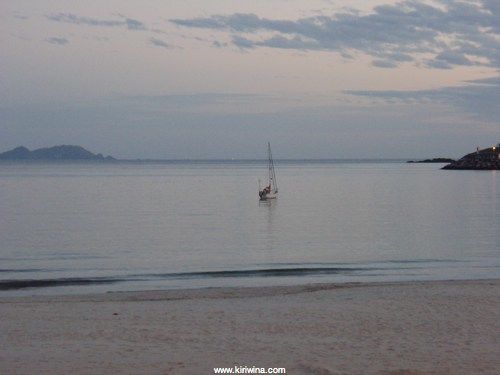
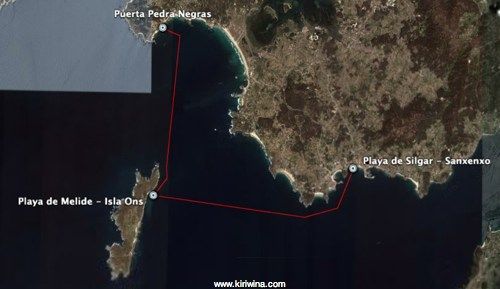
At 12:10 we passed the northern end of Isla Ons and anchored off Playa de Melide at 12:50. What a lovely spot.
At anchor off Playa de Melide, Isla de Ons

I rowed ashore in Kiriwini. The beach was deserted apart from one couple at the far end. The water was clear, the sand soft and warm underfoot just lovely.
A path led up and away from the beach through a forest of gum trees. It could easily have been in Australia.

The east coast is less harsh and far more verdant with woods of pine or eucaluptus
Looking south along the east coast with the only jetty in the distance.

The west coast is exposed to the full wrath of the atlantic. No beaches or trees here, just harsh jagged rocks and stumpy bushes.

A sailors memorial, typical of many on this coast. This one was to Anxo who was lost at sea aged only 22.

Vegetation found on the west coast. These plants are about 2-3 feet tall and are a little inland of the coast.
Those closer to the cliffs are only around 6" tall.

The lighthouse at the island's summit. A new slate paved road was being built to it leading up from the jetty.
There was also a helicopter pad and two banks of solar panels to provide some of the power.

I got blisters after walking most of the way round Isla de Ons. A really enjoyable stop.
We weighed anchor at 16:55 and sailed over to Playa de Silgar just west of the large marina at Sanxenxo where we anchored at 19:05.
Sculpture on a rock off Playa de Silgar

Sanxenxo is a largish visually challenged holiday town with a huge modern marina. I rowed ashore landing on the gently shelving Playa de Silgar for a walk around.
A Canadian yacht built in 1980 by it's owner who has been wandering around the world ever since. we were later to moor at the same dock.

Late evening, Playa de Silgar. It wasn't so tranquil the following morning.


Puerto Meloxo to Puerto Piedras Negras
27/May/2007 14:37 Filed in: Galicia
This morning I was woken by the boat moving about quite vigourously. It was raining heavily and a SW wind was blowing straight into the harbour. I would not have gone anywhere in those conditions but later the wind dropped and with the help of a local fisherman we got off the berth and away at 11:35, leaving a mooring line on the dock.
The weather moderated and we were able to sail most of the way round to Puerto Pedras Negras (Black Rocks) where we arrived at 14:30. By now it was fine and sunny. Arriving from the north it is necessary to make a wide sweep to the south to avoid a multitude of offlying rocks.
We are now clear of the Ria de Muros and in the Ensanada de Lanzana. The rocky coast is dotted with beautiful beaches some very small and one 3 miles long and the water is crystal clear.
Puerto Pedras Negras marina is very small with an apartment complex next door. I was told that it is no longer allowed to build apartments this close to the coast. It is a lovely location. The marina cost €13.33 per night and the facilities were just fine. There is a bar restaurant on the site with a two others on the beachfront nearby.
I went for a walk around the coast to the west. One can walk along the recently opened boardwalk or alternate between sandy beaches or rocky foreshore. The beaches were very clean and clear of the usual foreshore flotsam which appeared again further round the point away from the beaches.
Later I got a taxi back to Puerto Meloxo to retrieve my mooring line.
Approaching Puerto Pedras Negras before turning north. Ahead is Playa de Lanzada. Three mile of clean white sand.
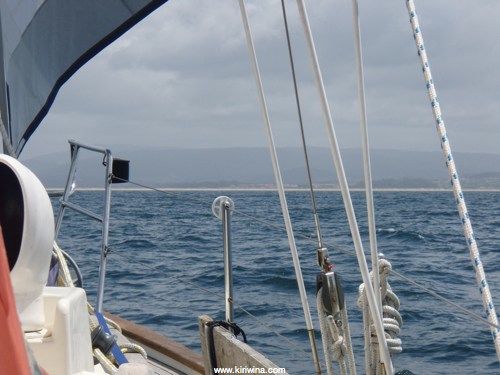
The small marina and adjacent apartments.
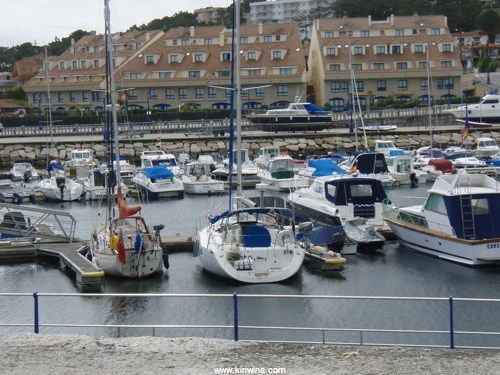
Promenade atop the marina breakwater.
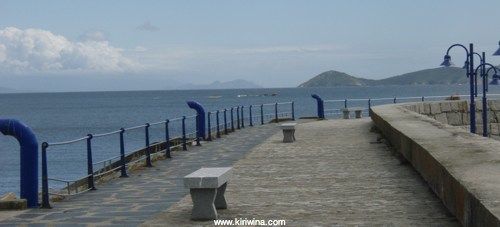
A reminder of how dangerous this coast can be.
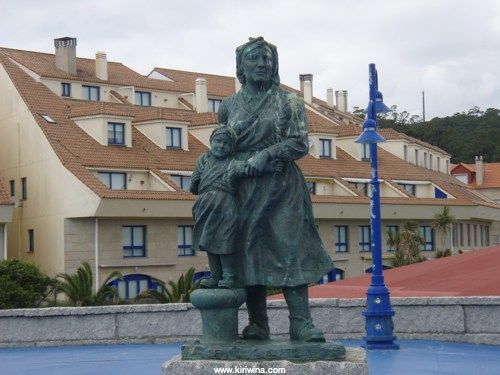
Playa de Barrosa 5 minutes walk from the marina.
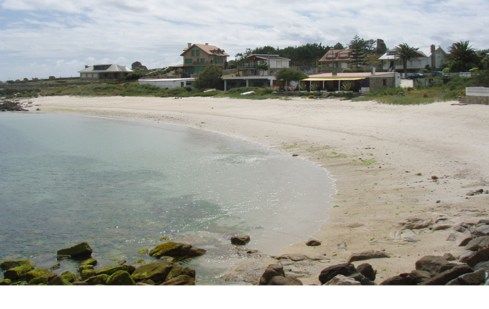
Self with Isla Ons in the background to the south and rocky shoals closer in. Note the water clarity.
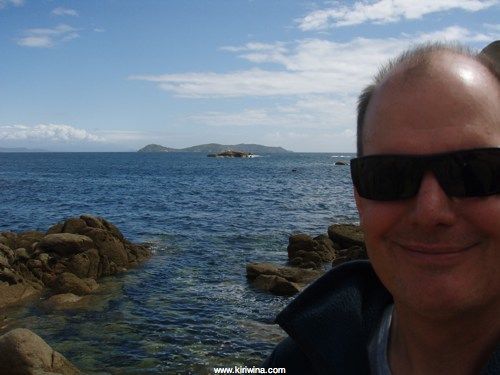
Redundant military installation near the SW corner of Peninsular O Grove.
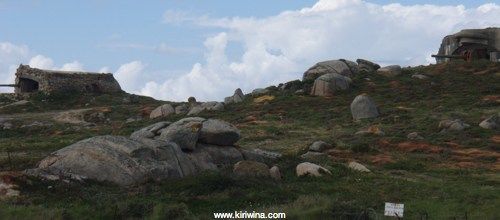
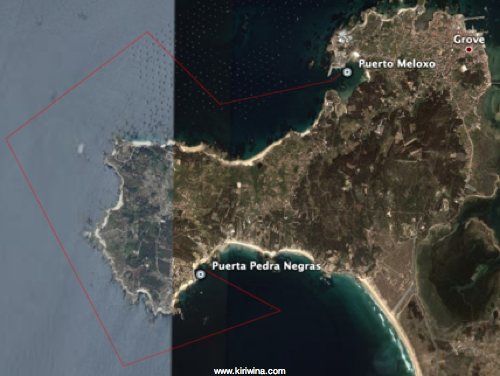
The weather moderated and we were able to sail most of the way round to Puerto Pedras Negras (Black Rocks) where we arrived at 14:30. By now it was fine and sunny. Arriving from the north it is necessary to make a wide sweep to the south to avoid a multitude of offlying rocks.
We are now clear of the Ria de Muros and in the Ensanada de Lanzana. The rocky coast is dotted with beautiful beaches some very small and one 3 miles long and the water is crystal clear.
Puerto Pedras Negras marina is very small with an apartment complex next door. I was told that it is no longer allowed to build apartments this close to the coast. It is a lovely location. The marina cost €13.33 per night and the facilities were just fine. There is a bar restaurant on the site with a two others on the beachfront nearby.
I went for a walk around the coast to the west. One can walk along the recently opened boardwalk or alternate between sandy beaches or rocky foreshore. The beaches were very clean and clear of the usual foreshore flotsam which appeared again further round the point away from the beaches.
Later I got a taxi back to Puerto Meloxo to retrieve my mooring line.
Approaching Puerto Pedras Negras before turning north. Ahead is Playa de Lanzada. Three mile of clean white sand.

The small marina and adjacent apartments.

Promenade atop the marina breakwater.

A reminder of how dangerous this coast can be.

Playa de Barrosa 5 minutes walk from the marina.

Self with Isla Ons in the background to the south and rocky shoals closer in. Note the water clarity.

Redundant military installation near the SW corner of Peninsular O Grove.


Cambados to Puerto Meloxo
26/May/2007 14:37 Filed in: Ria de Arosa
We left Cambados-Tragove at 09:40. A 20kn wind was blowing us hard onto the pontoon which made getting off interesting. having done so without incident we had a fast sail round to Puerto Meloxo where we arrived at 11:50.
The pontoons here have been installed for about two years and are occupied by mainly small craft. We slotted into one of the empty berths I had seen earlier. Puerto Meloxo is a small rock fringed bay occupied mostly by fishing vessels. The approaches are occupied by densely moored Viveiros through which one has to thread to reach the port.
Spent the afternoon with Chris and Carrie returning to the boat early in the evening.
O Grove, the connecting bridge and Isla de Toja seen from the north en route to Puerto Meloxo.
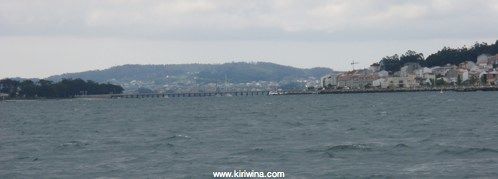
Approaches to Puerto Meloxo with moored fishing boats which must be passed to reach the pontoons.
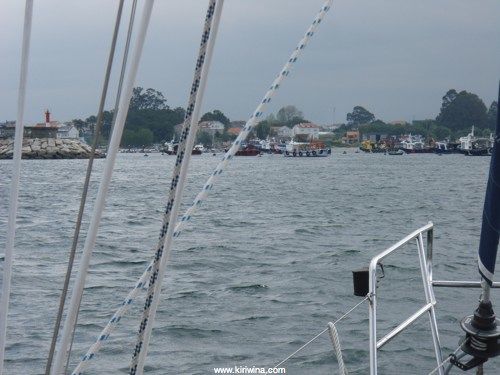
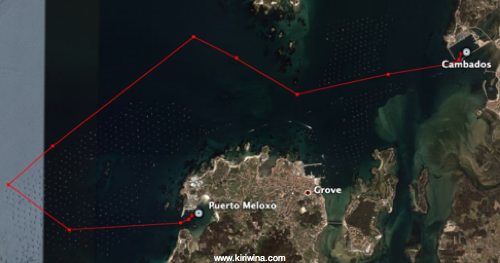
The pontoons here have been installed for about two years and are occupied by mainly small craft. We slotted into one of the empty berths I had seen earlier. Puerto Meloxo is a small rock fringed bay occupied mostly by fishing vessels. The approaches are occupied by densely moored Viveiros through which one has to thread to reach the port.
Spent the afternoon with Chris and Carrie returning to the boat early in the evening.
O Grove, the connecting bridge and Isla de Toja seen from the north en route to Puerto Meloxo.

Approaches to Puerto Meloxo with moored fishing boats which must be passed to reach the pontoons.


Cambados
25/May/2007 14:36 Filed in: Ria de Arosa
First up was a visit to the local library. Most libraries in Galicia have broadband internet access for all (European Union Regional Fund) where one can log on using their machines or ones own. One username /password is valid throughout Galicia.
Today I was able to visit one of the local Albariño wine producers. Fefiñanes. They have been winemakers since 1907 but the Palacio de Fifiñanes where the wine is bottled was built in the 17th century. Their website has the complete history and details of the wines, of which I bought a mixed case. They require groups of minimum 10 for a full tour but I was able to have a look araound and sample the product.
Winery courtyard.
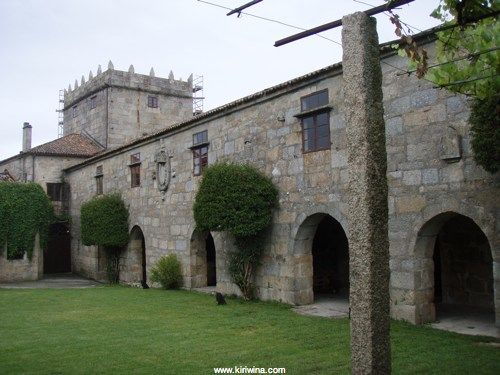
Product samples.
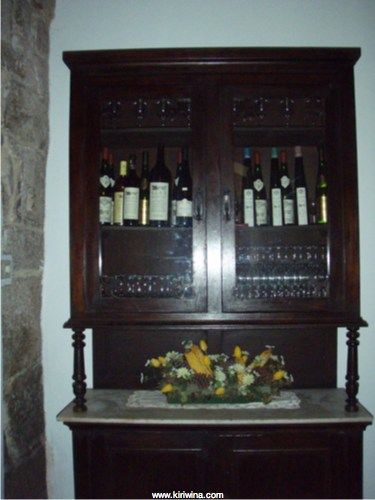
Cellar
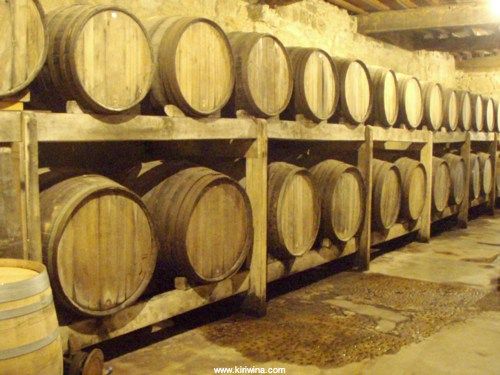
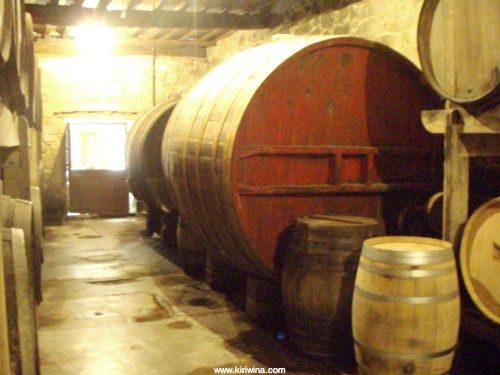
Antique labelling machine. Now they use a very clever Italian machine which bottles, corks and labels the wine.
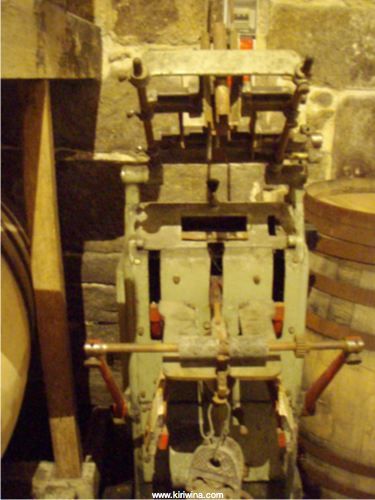
Pontoons at Cambados which are not shown in any guide. They have been in place for at least 2 years.
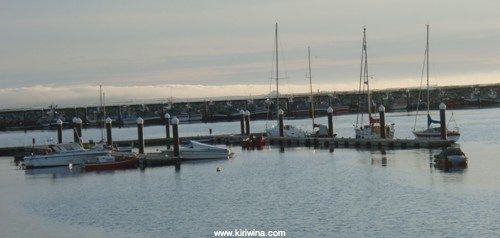
Back on board I got a call from Chris, a friend from Cheltenham, who is holidaying on Isla de Toxa. He and Carrie dropped by the boat for a quick visit and we agreed to meet tomorrow.
Today I was able to visit one of the local Albariño wine producers. Fefiñanes. They have been winemakers since 1907 but the Palacio de Fifiñanes where the wine is bottled was built in the 17th century. Their website has the complete history and details of the wines, of which I bought a mixed case. They require groups of minimum 10 for a full tour but I was able to have a look araound and sample the product.
Winery courtyard.

Product samples.

Cellar


Antique labelling machine. Now they use a very clever Italian machine which bottles, corks and labels the wine.

Pontoons at Cambados which are not shown in any guide. They have been in place for at least 2 years.

Back on board I got a call from Chris, a friend from Cheltenham, who is holidaying on Isla de Toxa. He and Carrie dropped by the boat for a quick visit and we agreed to meet tomorrow.
Caramiñal to Cambados
24/May/2007 14:11 Filed in: Ria de Arosa
An early night last night and up reasonably early this morning. Sad to say the quality of the marina shore facilities does not reflect the high beth cost.
Today it is one year since we left Dartmouth on this trip. We have sailed 2487.2 miles, visited 6 countries and called at 55 different ports and anchorages.
Had a quick run ashore for a coffee and a look around. A beautiful sunny day in a nice little town. El Pais reported this morning that the Spanish Americas Cup team had achieved third place in the qualifing rounds having been defeated by New Zealand 5-2. This is a very impressive achievement. They did better that the Americans who were beaten by Italy 5-1 while other sailing big hitters, the UK, France and Australia were nowhere to be seen. Well done Spain.
Back on board I left the mooring at 12:50 and anchored off the Playa Caramiñal for an hour or so while I sorted the boat out and plotted the course for Cambados. To quote the Galicia harbour guide "Entrance to the harbour entails quite a lot of difficulty, as you have to clear a large number of unmarked shoals and rafts, which requires expert knowledge of the area". This is overstating it a bit but I use a large scale paper chart and my Navionics electronic charts. Since I got the new display and Navionics charts last September they have proven to be much more up to date and accurate than the paper charts.
Isla Guidoro beacon and the rocky shoals behind
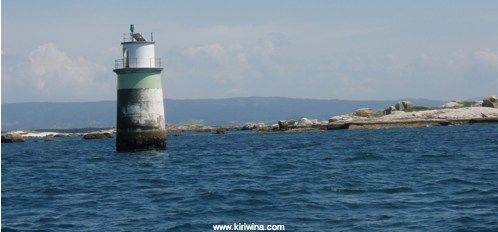
and on our starboard side Isla Rua with it's little lighthose.
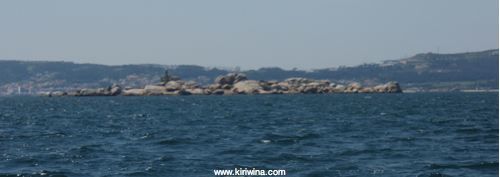
With a NW 10kn breeze I was able to sail off the anchorage at 14:55 using the Ghosting Genoa. There followed a lovely sail all the way into Cambados-Tragove harbour where I furled the sail and motored 2-300 metres to the berth arriving at 17:50. Pilotage inwards was pretty straight forward but there were some nasty rocks and shoals along the way. The wind increased to 17kn at times, a bit above Ghosting Genoa speed but I left it up anyway.
The pontoons in Cambados-Tragove were designed for Med style mooring with haul-off lines. However, the marina is so little used that the 3 other yachts there were moored fore and aft alongside using haul off lines to stay a metre or so off the pontoons and avoid wash damage from passing fishing boats. I did the same although the haul off lines were heavily encrusted with weed.
I took a quick run ashore but rain threatened and I got back just before the first of several thunder storms passed through.
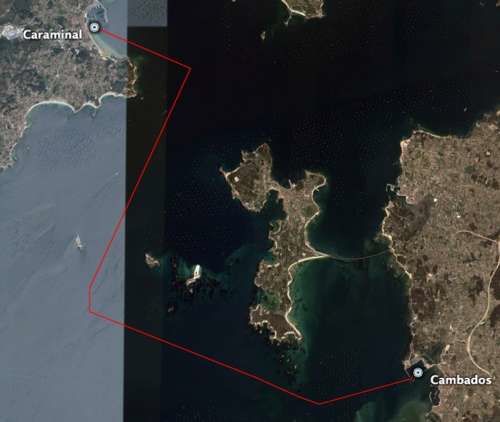
Today it is one year since we left Dartmouth on this trip. We have sailed 2487.2 miles, visited 6 countries and called at 55 different ports and anchorages.
Had a quick run ashore for a coffee and a look around. A beautiful sunny day in a nice little town. El Pais reported this morning that the Spanish Americas Cup team had achieved third place in the qualifing rounds having been defeated by New Zealand 5-2. This is a very impressive achievement. They did better that the Americans who were beaten by Italy 5-1 while other sailing big hitters, the UK, France and Australia were nowhere to be seen. Well done Spain.
Back on board I left the mooring at 12:50 and anchored off the Playa Caramiñal for an hour or so while I sorted the boat out and plotted the course for Cambados. To quote the Galicia harbour guide "Entrance to the harbour entails quite a lot of difficulty, as you have to clear a large number of unmarked shoals and rafts, which requires expert knowledge of the area". This is overstating it a bit but I use a large scale paper chart and my Navionics electronic charts. Since I got the new display and Navionics charts last September they have proven to be much more up to date and accurate than the paper charts.
Isla Guidoro beacon and the rocky shoals behind

and on our starboard side Isla Rua with it's little lighthose.

With a NW 10kn breeze I was able to sail off the anchorage at 14:55 using the Ghosting Genoa. There followed a lovely sail all the way into Cambados-Tragove harbour where I furled the sail and motored 2-300 metres to the berth arriving at 17:50. Pilotage inwards was pretty straight forward but there were some nasty rocks and shoals along the way. The wind increased to 17kn at times, a bit above Ghosting Genoa speed but I left it up anyway.
The pontoons in Cambados-Tragove were designed for Med style mooring with haul-off lines. However, the marina is so little used that the 3 other yachts there were moored fore and aft alongside using haul off lines to stay a metre or so off the pontoons and avoid wash damage from passing fishing boats. I did the same although the haul off lines were heavily encrusted with weed.
I took a quick run ashore but rain threatened and I got back just before the first of several thunder storms passed through.

Vilagarcia to Caramiñal
23/May/2007 15:20 Filed in: Ria de Arosa
Time to leave Vilagarcia. I've really enjoyed it here. The Marina has excellent facilities, is very central and has friendly, helpful staff. All for €11 per day. There are good transport links to other towns on the Ria and to Santiago, La Coruña and Vigo. An excellent place to stop.
Just a short run today and a bit of a grumble.
Said goodby to Gerry and Isolde on "Northern Sky" and had a gentle sail down the Ria to Caramiñal. A distance of just over 7 miles.
A pattern is beginning to emerge with marinas built and owned by Ports Galicia and operated under contract by various Club Nauticos as is the one in Caramiñal. They charge like wounded bulls. The clubs say they are told what to charge by Ports Galicia but I'm not so sure.
My cost tonight for an 8.5m boat is €18 and it's not yet high season. Actually it's the cost for a 12m boat and that's what I have to pay even though they chose to put me in that berth and there were a lot of smaller berths that were empty. This cost ranks amongst the highest I have paid on the European mainland including Holland, Denmark and Germany. Ribeira and Portosin were similar. It does not encourage one to stay and spend some time and money. Had it been a bit earlier I would have gone back to Vilagarcia or anchored.
In future I think I am going to have to anchor a lot more to achieve my daily port cost target of €10. A third element to my observations on moving south. The palms get taller, port entry forms get bigger and marina charges increase.
I've also managed to lose my mobile phone. Not the best of days.
Caramiñal is a very pretty little town and I'm off to have a look around.
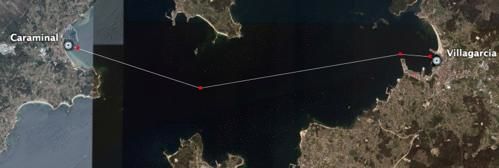
Just a short run today and a bit of a grumble.
Said goodby to Gerry and Isolde on "Northern Sky" and had a gentle sail down the Ria to Caramiñal. A distance of just over 7 miles.
A pattern is beginning to emerge with marinas built and owned by Ports Galicia and operated under contract by various Club Nauticos as is the one in Caramiñal. They charge like wounded bulls. The clubs say they are told what to charge by Ports Galicia but I'm not so sure.
My cost tonight for an 8.5m boat is €18 and it's not yet high season. Actually it's the cost for a 12m boat and that's what I have to pay even though they chose to put me in that berth and there were a lot of smaller berths that were empty. This cost ranks amongst the highest I have paid on the European mainland including Holland, Denmark and Germany. Ribeira and Portosin were similar. It does not encourage one to stay and spend some time and money. Had it been a bit earlier I would have gone back to Vilagarcia or anchored.
In future I think I am going to have to anchor a lot more to achieve my daily port cost target of €10. A third element to my observations on moving south. The palms get taller, port entry forms get bigger and marina charges increase.
I've also managed to lose my mobile phone. Not the best of days.
Caramiñal is a very pretty little town and I'm off to have a look around.

To O Grove and Isla de Toxa
22/May/2007 16:45 Filed in: Ria de Arosa
Later this week I will be having a drink with some friends holidaying in O Grove and I wanted to explore berthing possibilities.
This was a bus ride of about an hour and a quarter. As we came into O Grove we passed the bridge to Isla de Toja of which more later. O Grove is a popular holiday town but it was still off season as many restaurants were closed and not too many people were about. O Grove harbour was full of fishing and tourist boats with only a few local yachts on buoys. No mooring here then.
A brochure I got from Cambados tourist office yesterday said there were yacht berths at Porto Meloxo further round the peninsular. Under estimating the map scale I ended up with a 70 minute walk. Again, where the charts and guides show a shallow harbour for fishing boats, there were two newish yacht pontoons with most of the berths taken up by very small dinghies and runabouts. There was plenty of water and several empty berths. In common with Cambados there was open access to the pontoons but no sign at all as to who and or what the visitor would pay in the unlikely event that a visiting yacht made it's way to one of these harbours. Perhaps I will try as the only alternative is to anchor off near O Grove and dinghy in.
I walked back to O Grove and crossed the bridge to Isla de Toja. This bridge has been recently restored having originally been built in 1910 as the first concrete arch bridge in Galicia.
Bridge to Isla de Toja at low tide looking towards O Grove.
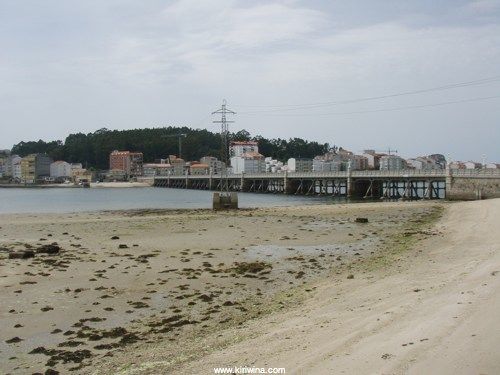
Isla de Toja came with something of a build-up. My friends in La Coruña had circled it on the map. My pilot book refers to it as a holiday destination for the very rich, Franco was known to take holidays here and there are two thermal spas, two large hotels, a conference centre and a casino. I must confess to being quite underwhelmed.
The island is not large and can be walked around in 80 or so minutes. At the bridge exit there is a private security office and security guards patrol the island in yellow vans. Along the south side of the island is a publicly funded Paseo Maritime built only 9 years ago but already bits of it have fallen onto the rocks below.
First large hotel looked fine but the Casino looked tired and next door was what appeared to be a derelict Spa.
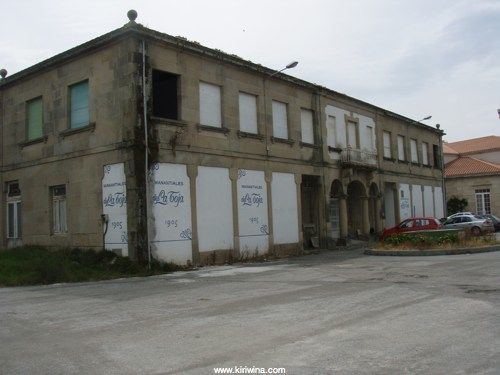
A church with an exterior clad completely in seashells was quite charming.
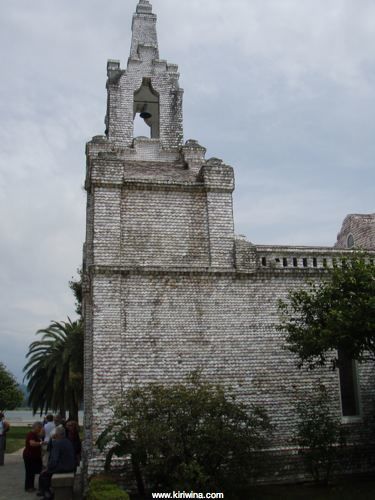
The Gran Hotel Hesperia de Toja, said by one guide to be most expensive (2 person suite €262.15) in Galicia, looked lovely.
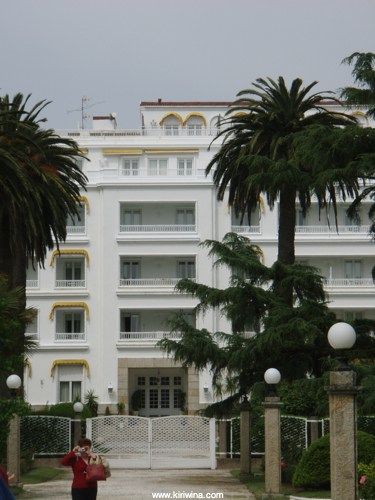
It's beach less so.
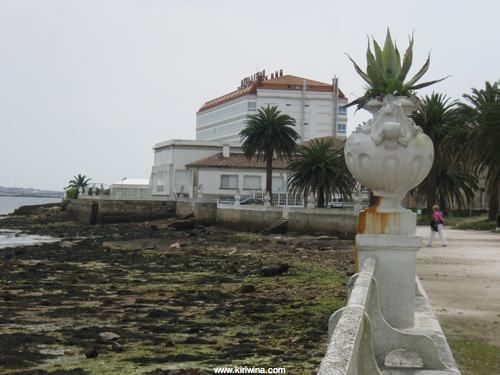
The Beach and Tennis Club was closed and very run down.
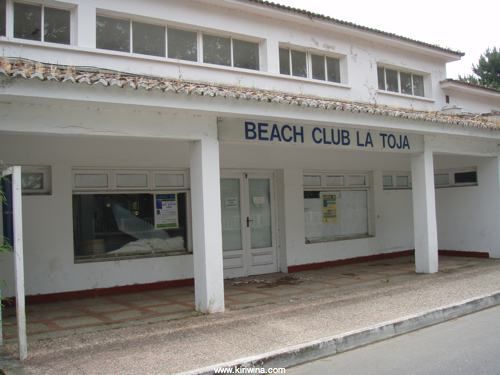
There were no sandy white beaches. The Convention Centre looked closed and the approach road was breaking up. The Gran Hotel had a jetty but there was no dock for visiting boats. There were lots of big expensive houses.
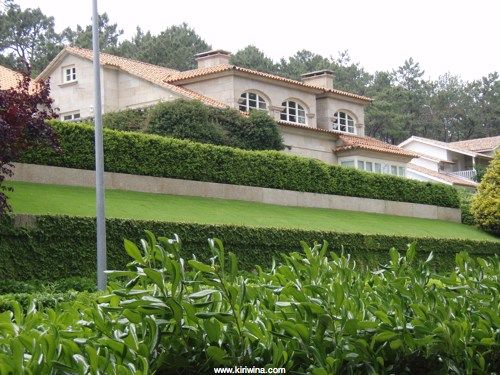
Some with tired paintwork. Apart from the Gran Hotel and the Hesperia Isla de la Toja Hotel and Spa much of what was there needed at best some tlc and at worst major refurbishing. The words faded and glory sprang to mind although there was a lot of building activity and new developments.
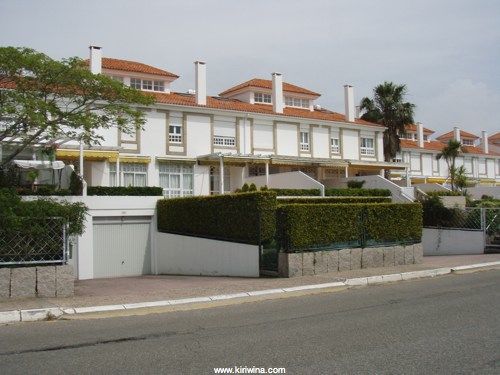
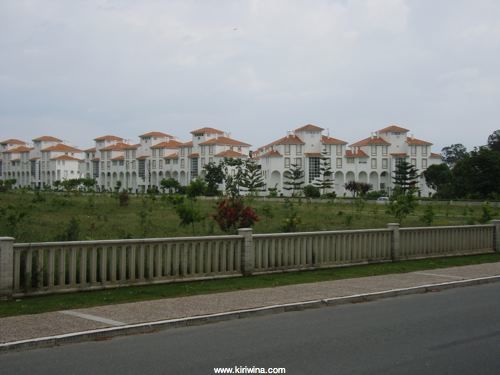
O Grove was quite a nice spot with a lot of restaurants and hotels which I suspect will be very busy in the summer.
Back in Vilagarcia the festival Santa Rita had begun.
Part of a busy street had been closed off and two huge sound stages erected. Later in the evening there was free entertainment from two "Orchestras", though I would use the term show band, "Paris de Noia" and "Gran Parada". The music might best be described as latin swing and the street was filled with mostly older people dancing. The brass sections were particularly good.
This was a bus ride of about an hour and a quarter. As we came into O Grove we passed the bridge to Isla de Toja of which more later. O Grove is a popular holiday town but it was still off season as many restaurants were closed and not too many people were about. O Grove harbour was full of fishing and tourist boats with only a few local yachts on buoys. No mooring here then.
A brochure I got from Cambados tourist office yesterday said there were yacht berths at Porto Meloxo further round the peninsular. Under estimating the map scale I ended up with a 70 minute walk. Again, where the charts and guides show a shallow harbour for fishing boats, there were two newish yacht pontoons with most of the berths taken up by very small dinghies and runabouts. There was plenty of water and several empty berths. In common with Cambados there was open access to the pontoons but no sign at all as to who and or what the visitor would pay in the unlikely event that a visiting yacht made it's way to one of these harbours. Perhaps I will try as the only alternative is to anchor off near O Grove and dinghy in.
I walked back to O Grove and crossed the bridge to Isla de Toja. This bridge has been recently restored having originally been built in 1910 as the first concrete arch bridge in Galicia.
Bridge to Isla de Toja at low tide looking towards O Grove.

Isla de Toja came with something of a build-up. My friends in La Coruña had circled it on the map. My pilot book refers to it as a holiday destination for the very rich, Franco was known to take holidays here and there are two thermal spas, two large hotels, a conference centre and a casino. I must confess to being quite underwhelmed.
The island is not large and can be walked around in 80 or so minutes. At the bridge exit there is a private security office and security guards patrol the island in yellow vans. Along the south side of the island is a publicly funded Paseo Maritime built only 9 years ago but already bits of it have fallen onto the rocks below.
First large hotel looked fine but the Casino looked tired and next door was what appeared to be a derelict Spa.

A church with an exterior clad completely in seashells was quite charming.

The Gran Hotel Hesperia de Toja, said by one guide to be most expensive (2 person suite €262.15) in Galicia, looked lovely.

It's beach less so.

The Beach and Tennis Club was closed and very run down.

There were no sandy white beaches. The Convention Centre looked closed and the approach road was breaking up. The Gran Hotel had a jetty but there was no dock for visiting boats. There were lots of big expensive houses.

Some with tired paintwork. Apart from the Gran Hotel and the Hesperia Isla de la Toja Hotel and Spa much of what was there needed at best some tlc and at worst major refurbishing. The words faded and glory sprang to mind although there was a lot of building activity and new developments.


O Grove was quite a nice spot with a lot of restaurants and hotels which I suspect will be very busy in the summer.
Back in Vilagarcia the festival Santa Rita had begun.
Part of a busy street had been closed off and two huge sound stages erected. Later in the evening there was free entertainment from two "Orchestras", though I would use the term show band, "Paris de Noia" and "Gran Parada". The music might best be described as latin swing and the street was filled with mostly older people dancing. The brass sections were particularly good.
To Cambados
21/May/2007 17:17 Filed in: Ria de Arosa
According to my charts and pilot books a lot of the ports scattered around Ria Arosa are not really suitable for yachts. This includes several otherwise desirable places.
Today I caught the bus to Cambados. The route followed the coast and even crossed over to Isla de Arosa during the 40 min trip. Cambados is a very pretty little town and is the capital of Albariño wine. A very tasty white.
I arrived around 14:30 and had a good walk around. There were a number of shops selling Albariño wines but I held off buying until I have a bit more information. There are the remains of a lighthouse originally built in the tenth century and two ports primarily dedicated to fishing. Cambados had a much more groomed town centre than many I have visited. The streets and paths were paved in stone and the entire waterfront was bordered by an impressive promenade.
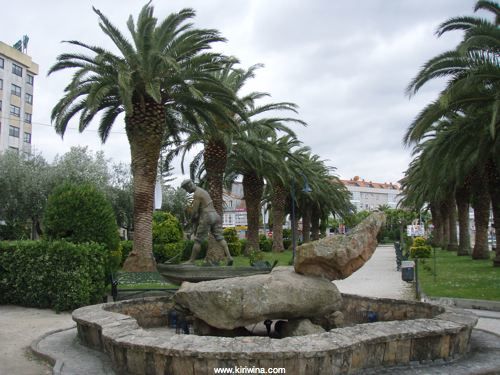
Galicia has many many beautiful sandy beaches but the Ria de Arosa does not seem to have got it's fair share. Here many beaches have a very shallow slope and the tide recedes a longway often leaving a rocky weed covered area frequently with a good deal of rubbish and of little merit.
Beach near Cambados with two large hotels on Isla de Toja in the distance.
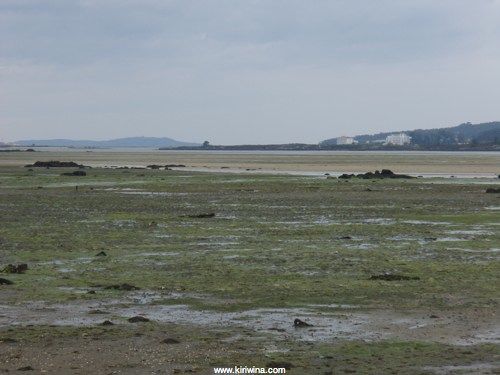
When the tide is in, however, the waterfront looks lovely.
A walk over to the larger of the two fishing harbours confirmed my suspicion that a lot of the recent investment by the Galician Xunta in yacht facilities has yet to find it's way onto to the charts and other guides. A smallish modern yacht pontoon had been installed and was virtually unused. The few yachts there were looking very unloved but the berths looked fine with plenty of water. The chart shows only 1.5m but there was clearly a lot more water than that.
There is no security but it looked like a good place for a quick stop.
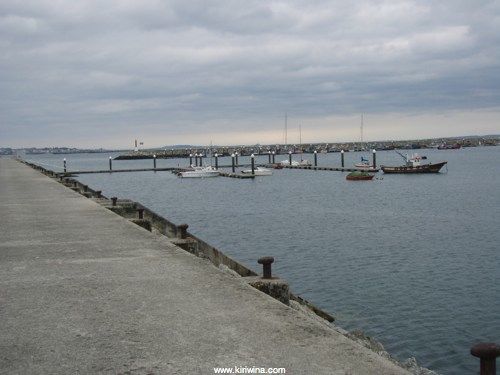
I also came across another of the water troughs that I had first seen in Redes. They are public laundries although where clothes can be washed, rinsed and hung out to dry.
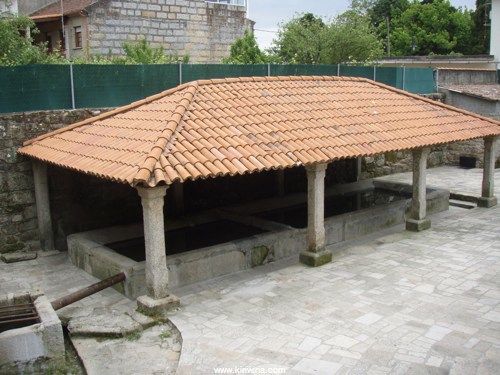
Caught the bus back around 18:00 and later had dinner in the Club del Mar with Gerry and Isolde from "Northern Sky". An all sea food meal as well. The baby squid and pulpo was particularly nice as was the Alboriño wine which washed it down.
Today I caught the bus to Cambados. The route followed the coast and even crossed over to Isla de Arosa during the 40 min trip. Cambados is a very pretty little town and is the capital of Albariño wine. A very tasty white.
I arrived around 14:30 and had a good walk around. There were a number of shops selling Albariño wines but I held off buying until I have a bit more information. There are the remains of a lighthouse originally built in the tenth century and two ports primarily dedicated to fishing. Cambados had a much more groomed town centre than many I have visited. The streets and paths were paved in stone and the entire waterfront was bordered by an impressive promenade.

Galicia has many many beautiful sandy beaches but the Ria de Arosa does not seem to have got it's fair share. Here many beaches have a very shallow slope and the tide recedes a longway often leaving a rocky weed covered area frequently with a good deal of rubbish and of little merit.
Beach near Cambados with two large hotels on Isla de Toja in the distance.

When the tide is in, however, the waterfront looks lovely.
A walk over to the larger of the two fishing harbours confirmed my suspicion that a lot of the recent investment by the Galician Xunta in yacht facilities has yet to find it's way onto to the charts and other guides. A smallish modern yacht pontoon had been installed and was virtually unused. The few yachts there were looking very unloved but the berths looked fine with plenty of water. The chart shows only 1.5m but there was clearly a lot more water than that.
There is no security but it looked like a good place for a quick stop.

I also came across another of the water troughs that I had first seen in Redes. They are public laundries although where clothes can be washed, rinsed and hung out to dry.

Caught the bus back around 18:00 and later had dinner in the Club del Mar with Gerry and Isolde from "Northern Sky". An all sea food meal as well. The baby squid and pulpo was particularly nice as was the Alboriño wine which washed it down.
Return to Vilagarcia
20/May/2007 18:05 Filed in: Ria de Muros
Got up reasonably early and caught the 10:40 train From Santiago de Compostela to Vilagarcia. The weather has turned nasty. It is cloudy with showers and NW F7 is forecast.
Spend the day doing odd jobs about the boat including fitting a bottle screw and chain to secure the anchor for sea without using the windlass and fitting an LED bulb to the refurbished port berth reading light.
Both reading lights have now been fitted LED clusters from BEBI. They give out a whiter much stronger light than the 10w bulb they replace. A great improvement. The port one which had started to tarnish badly after it got splashed with salt water polished up really well with Solvol Autosol. It was then coated with synthetic varnish. Not a perfect finish but if it doesn't tarnish I will be happy.
Spend the day doing odd jobs about the boat including fitting a bottle screw and chain to secure the anchor for sea without using the windlass and fitting an LED bulb to the refurbished port berth reading light.
Both reading lights have now been fitted LED clusters from BEBI. They give out a whiter much stronger light than the 10w bulb they replace. A great improvement. The port one which had started to tarnish badly after it got splashed with salt water polished up really well with Solvol Autosol. It was then coated with synthetic varnish. Not a perfect finish but if it doesn't tarnish I will be happy.
Santiago di Compostella
19/May/2007 18:16 Filed in: Galicia
Concert day today. Cleaned the boat and then tried to sort out my e-mail arrangements on the new servers. Part of it was quite easy but there were some complications where what I had in front of me was inconsistent with the instructions given and I was being given error messages. Very frustrating so mailed a grumble to tech support..
Then I had an hour or two before the train left for Santiago. Spent the time relaxing in a street cafe being entertained by a bunch of old boys sitting outside the cafe opposite singing traditional Galician songs.
The train ride to Santiago is only around 45 minutes. I hadn't booked a hotel and while walking up from the station found one in a perfect location. The Hotel Hórreo was very close to the town centre and within walking distance of Multiusos Fontes Do Sar where the concert is being held. I think I got the last room. It was very comfortable and pretty reasonable at €40 per night.
There were two hours before show time at 20:00 so I went for a coffee and read the paper. The last few minutes of the FA cup with Spanish commentary was on the tele.
It was about a 30 minute walk to Multiusos and I would say the majority of the people I saw walking up were south of 30. There was no queuing to get into the hall and they had a way of serving drinks that I had not seen. One booth sells you a ticket which you take to another booth which gives you your drink. I had forgotten my old rule which is never ever to buy anything other than the entrance ticket to an event. They were selling drink tickets much faster than they were serving drinks and with pot luck as to who was served it took a long while to get my drink. Grrr.
Quite a nice venue but the concert was no way sold out. The floor was pretty full but the cheaper side seats were largely empty. We were to be entertained by the Van Morrison Orchestra of 7 musicians, two doowah girls and Van himself.
Proceedings started pretty well on time with Van coming on after one warm up number. I had been very disappointed with Van Morrison when I saw him play in Cheltenham a few years ago. Tonight he was in fine form and the band was good. Most of the songs were more recent and only towards the end did they play a few classics. The show finished after only an hour and a half with "Gloria" and that was it. No encore, lights on and you can all go home. It was still light outside at 21:30 and I was left thinking, well, is that it!
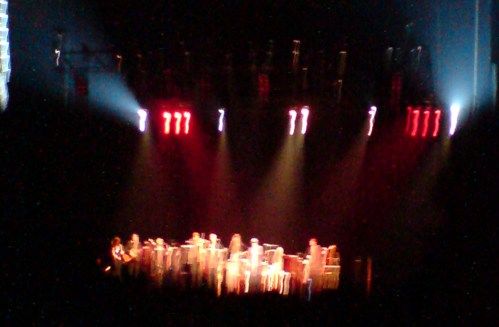
Back in the town centre other musical activity was taking place. More traditional street musicians who were very good and an excellent latin trio, I think from Cuba, playing on a council sponsored stage.
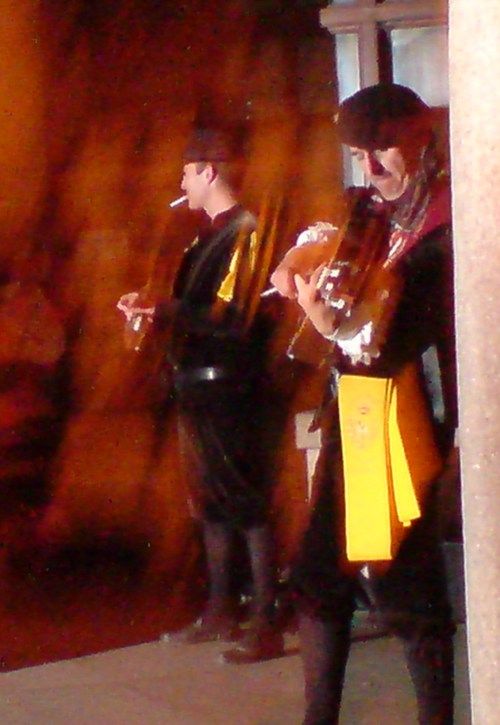
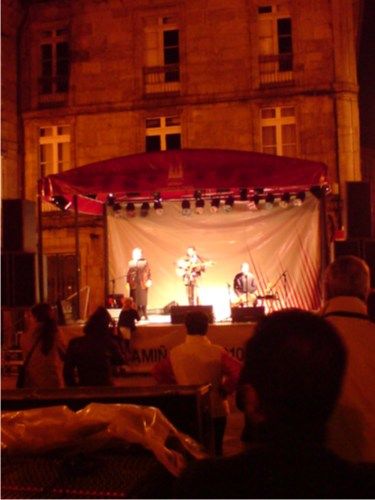
All in all a good musical day but not in the way I had expected.
Then I had an hour or two before the train left for Santiago. Spent the time relaxing in a street cafe being entertained by a bunch of old boys sitting outside the cafe opposite singing traditional Galician songs.
The train ride to Santiago is only around 45 minutes. I hadn't booked a hotel and while walking up from the station found one in a perfect location. The Hotel Hórreo was very close to the town centre and within walking distance of Multiusos Fontes Do Sar where the concert is being held. I think I got the last room. It was very comfortable and pretty reasonable at €40 per night.
There were two hours before show time at 20:00 so I went for a coffee and read the paper. The last few minutes of the FA cup with Spanish commentary was on the tele.
It was about a 30 minute walk to Multiusos and I would say the majority of the people I saw walking up were south of 30. There was no queuing to get into the hall and they had a way of serving drinks that I had not seen. One booth sells you a ticket which you take to another booth which gives you your drink. I had forgotten my old rule which is never ever to buy anything other than the entrance ticket to an event. They were selling drink tickets much faster than they were serving drinks and with pot luck as to who was served it took a long while to get my drink. Grrr.
Quite a nice venue but the concert was no way sold out. The floor was pretty full but the cheaper side seats were largely empty. We were to be entertained by the Van Morrison Orchestra of 7 musicians, two doowah girls and Van himself.
Proceedings started pretty well on time with Van coming on after one warm up number. I had been very disappointed with Van Morrison when I saw him play in Cheltenham a few years ago. Tonight he was in fine form and the band was good. Most of the songs were more recent and only towards the end did they play a few classics. The show finished after only an hour and a half with "Gloria" and that was it. No encore, lights on and you can all go home. It was still light outside at 21:30 and I was left thinking, well, is that it!

Back in the town centre other musical activity was taking place. More traditional street musicians who were very good and an excellent latin trio, I think from Cuba, playing on a council sponsored stage.


All in all a good musical day but not in the way I had expected.
Vilagarcia
18/May/2007 16:15 Filed in: Ria de Arosa
First stop today is Caixa Galicia. My Van Morrison ticket has arrived. They check my ID and hand it over. The system worked well in the end. It's a shame they can't resist preying on customers who can't order online.
Then I visited the internet cafe to upload this site to the new servers provided by MacHighway. I had been having some difficulties uploading to the old server which I attributed to the software I was using. Perhaps not. The upload was very fast and achieved at the first attempt.
After lunch I tackled a couple of jobs. Kiriwina has a Par automatic bilge pump which can be triggered manually or via a Par Hydro-Air switch. The latter had not worked for some time. I last looked at it in Dartmouth and found that the air tube was disconnected. It still did not work when the tube was put back. I removed the switch for closer inspection and found that the rubber gaiter connecting the air tube to the switch was split. This was why the tube had originally disconnected but the split was not visible with the switch in situ.
Not having a new gaiter I sealed the joint with tape, filled the bilge and bingo off it went. One problem solved but another emerged. A small fuel leak has developed from the primary engine filter. This was serviced last September and it may be that the filter is not seated properly. This will be messy to pull apart so I put a container underneath to see how bad the leak is before doing anything.
Then I visited the internet cafe to upload this site to the new servers provided by MacHighway. I had been having some difficulties uploading to the old server which I attributed to the software I was using. Perhaps not. The upload was very fast and achieved at the first attempt.
After lunch I tackled a couple of jobs. Kiriwina has a Par automatic bilge pump which can be triggered manually or via a Par Hydro-Air switch. The latter had not worked for some time. I last looked at it in Dartmouth and found that the air tube was disconnected. It still did not work when the tube was put back. I removed the switch for closer inspection and found that the rubber gaiter connecting the air tube to the switch was split. This was why the tube had originally disconnected but the split was not visible with the switch in situ.
Not having a new gaiter I sealed the joint with tape, filled the bilge and bingo off it went. One problem solved but another emerged. A small fuel leak has developed from the primary engine filter. This was serviced last September and it may be that the filter is not seated properly. This will be messy to pull apart so I put a container underneath to see how bad the leak is before doing anything.
Vilagarcia - Fixing the Eberspacher
17/May/2007 15:14 Filed in: Ria de Arosa
Today is a public holiday with lovely weather. I was chatting again with Gerry from "Northern Sky" had explained some details of how Eberspacher boat heaters work. Mine had not worked since last summer so I was very interested to see if I could fix it.
I went through the procedures he had outlined and some items from the user manual. A long and very fiddly process. Nothing untoward was found was found and when I turned it on not a lot happened. Gerry had been very insistent that patience was required with Eberspachers. I waited. Then it began to fire up and after a few minutes was running properly. I suspect that the battery connections were slightly corroded. Brilliant, thanks Gerry.
I went through the procedures he had outlined and some items from the user manual. A long and very fiddly process. Nothing untoward was found was found and when I turned it on not a lot happened. Gerry had been very insistent that patience was required with Eberspachers. I waited. Then it began to fire up and after a few minutes was running properly. I suspect that the battery connections were slightly corroded. Brilliant, thanks Gerry.
Vilagarcia - New Servers
16/May/2007 15:14 Filed in: Ria de Arosa
While having a morning coffee in the marina restaurant I meet Gerry and Isolde from a 39ft Beneteau "Northern Sky". They are Canadians who are off on a round the world cruise.
This website has now outgrown the server arrangements I put in place a couple of years ago. I need to find new servers. Not an easy decision given how many there are. I spent far too long online researching this and drank too much coffee but in the end I got a result.
Realmac Software who produce RapidWeaver which I use to create this site have a very useful user forum. A section of this discusses hosting arrangements for websites and from there I was able to source a company that use only Apple servers, MacHighway.
The transfer procedure appeared to be very easy so I went ahead. It looks as though I will have to pay around same as before but the capacity available to me is much greater.
This website has now outgrown the server arrangements I put in place a couple of years ago. I need to find new servers. Not an easy decision given how many there are. I spent far too long online researching this and drank too much coffee but in the end I got a result.
Realmac Software who produce RapidWeaver which I use to create this site have a very useful user forum. A section of this discusses hosting arrangements for websites and from there I was able to source a company that use only Apple servers, MacHighway.
The transfer procedure appeared to be very easy so I went ahead. It looks as though I will have to pay around same as before but the capacity available to me is much greater.
Riviera to Vilagarcia
15/May/2007 17:44 Filed in: Ria de Muros
A beautiful day today. Another walk ashore this morning to get some groceries and enjoy a coffee.
The marina has free WiFi which worked on the boat at least 300 metres from the office but not in the cafe next door. This cafe had a neat marketing idea. At around 12:00 they distributed samples of the menu del dia. Extremely useful for self who has yet to memorise a workable spanish menu vocabulary.
Paid my bill and noticed that the club received a recent visit from El Rey, Juan Carlos. Photographs of the occasion occupied pride of place in reception. I get the impression that El Rey quite likes his sailing. He seems to have visited a lot of Club Nauticos in this area. His interest must be to good effect as in El Pais the other day they reported that the Spanish team had made the final four in the Americas Cup trials in Valencia.
Before leaving I tried again, having failed the first time in Portosin, to buy a ticket for the Van Morrison concert in Santiago de Compostela next saturday. I think I succeeded but not before being exposed to the sort of slime-ball customer abuse so common in England. Tickets offered on one website only, Caixa Galicia. Website does not work so phone help line on a rip-off rate (902) to be told there would be a surcharge because I didn't order on the website. Hung up and tried the website again. I hope it worked but I have to go to a branch of Caixa Galicia to get my ticket.
At 14:30 we left Riveira bound for Vilagarcia. The wind was right behind us at around WNW F2-3. We sailed all the way to Vilagarcia on the yankee only. Not very fast but very relaxing.
An alert regular reader asked what are the obstacles in the water on some google earth pictures.
They are called Viveiros and are large floating wooden rafts which function as mussel farms. Mussels grow on ropes which hang vertically under the Viveiros.
A Viveiro in the Ria Arosa. It is sitting low in the water indicating a pending harvest.
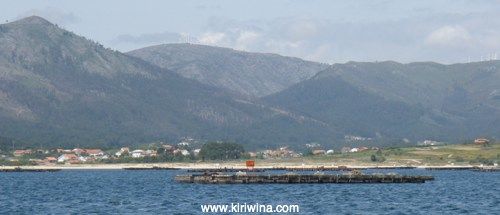
More Viveiros. The vessel alongside is harvesting mussels.

One of the pilot books I use refers to Villagarcia as "not very attractive". I'm not so sure about that. Just after arrival on the waiting berth at 18:00 we were met by the marinero who allocated our berth and helped with mooring.
Vilagarcia has a large marina with a pleasant Club de Mar with free internet, brand new chandler and a city centre only a few minutes walk away. I had a quick walk around this evening and was quite impressed.
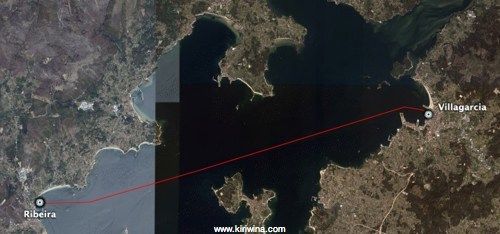
The marina has free WiFi which worked on the boat at least 300 metres from the office but not in the cafe next door. This cafe had a neat marketing idea. At around 12:00 they distributed samples of the menu del dia. Extremely useful for self who has yet to memorise a workable spanish menu vocabulary.
Paid my bill and noticed that the club received a recent visit from El Rey, Juan Carlos. Photographs of the occasion occupied pride of place in reception. I get the impression that El Rey quite likes his sailing. He seems to have visited a lot of Club Nauticos in this area. His interest must be to good effect as in El Pais the other day they reported that the Spanish team had made the final four in the Americas Cup trials in Valencia.
Before leaving I tried again, having failed the first time in Portosin, to buy a ticket for the Van Morrison concert in Santiago de Compostela next saturday. I think I succeeded but not before being exposed to the sort of slime-ball customer abuse so common in England. Tickets offered on one website only, Caixa Galicia. Website does not work so phone help line on a rip-off rate (902) to be told there would be a surcharge because I didn't order on the website. Hung up and tried the website again. I hope it worked but I have to go to a branch of Caixa Galicia to get my ticket.
At 14:30 we left Riveira bound for Vilagarcia. The wind was right behind us at around WNW F2-3. We sailed all the way to Vilagarcia on the yankee only. Not very fast but very relaxing.
An alert regular reader asked what are the obstacles in the water on some google earth pictures.
They are called Viveiros and are large floating wooden rafts which function as mussel farms. Mussels grow on ropes which hang vertically under the Viveiros.
A Viveiro in the Ria Arosa. It is sitting low in the water indicating a pending harvest.

More Viveiros. The vessel alongside is harvesting mussels.

One of the pilot books I use refers to Villagarcia as "not very attractive". I'm not so sure about that. Just after arrival on the waiting berth at 18:00 we were met by the marinero who allocated our berth and helped with mooring.
Vilagarcia has a large marina with a pleasant Club de Mar with free internet, brand new chandler and a city centre only a few minutes walk away. I had a quick walk around this evening and was quite impressed.

Portosin to Riveira
14/May/2007 07:15 Filed in: Ria de Muros
When I got up today there was not a breath of wind in the marina. Theyr, Meteo France and INM were all forecasting NW winds F3-4. Pretty well perfect for our southerly passage.
At the marina office they gave me a discount of 15% to compensate for the hot water malfunction during my first two days.
We cleared Portosin harbour at 11:00 and motorsailed for about an hour. Thereafter we had a cracking sail with main and yankee at varying speeds all the way to Riviera only motoring the last mile or so directly into the wind. This passage required some care due to the number of unmarked shoals well off the coast and we stayed well out to sea.
After the strong winds of recent days there was a substantial swell, INM said 3m, and if anything their forecast was a tad on the low side. I was surprised that the swell was from the NW when recent weather had been SW. As the afternoon wore on the wind increased and for the last two hours we had NW F6.
At 17:00 we passed the southern tip of Isla de Salvora with it's nasty offlying rocks. The passage north of Salvora is much quicker but is recommended only in calm conditions.
Southern tip of Isla De Salvora.
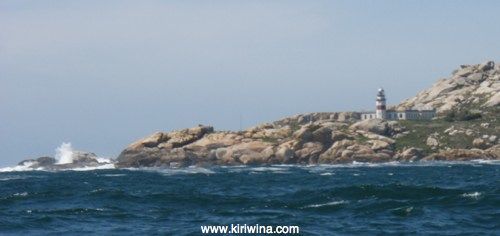
We were all fast at Club Nautico de Riveira just after 19:00. Another ouch on marina costs. One night cost €18. So far marina costs have doubled since we got round Cabo Finisterre and it's not yet high season.
Riviera is a large fishing port and work continues late into the evening with regular loud blasts on a siren the purpose of which escaped me. Took a quick walk ashore. Quite a long strip of bars and cafes along the harbourfront but not a lot to warrant more than an overnight stay.
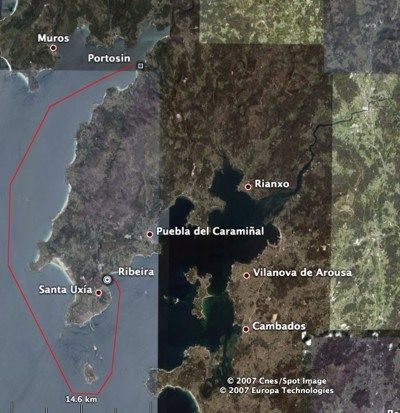
At the marina office they gave me a discount of 15% to compensate for the hot water malfunction during my first two days.
We cleared Portosin harbour at 11:00 and motorsailed for about an hour. Thereafter we had a cracking sail with main and yankee at varying speeds all the way to Riviera only motoring the last mile or so directly into the wind. This passage required some care due to the number of unmarked shoals well off the coast and we stayed well out to sea.
After the strong winds of recent days there was a substantial swell, INM said 3m, and if anything their forecast was a tad on the low side. I was surprised that the swell was from the NW when recent weather had been SW. As the afternoon wore on the wind increased and for the last two hours we had NW F6.
At 17:00 we passed the southern tip of Isla de Salvora with it's nasty offlying rocks. The passage north of Salvora is much quicker but is recommended only in calm conditions.
Southern tip of Isla De Salvora.

We were all fast at Club Nautico de Riveira just after 19:00. Another ouch on marina costs. One night cost €18. So far marina costs have doubled since we got round Cabo Finisterre and it's not yet high season.
Riviera is a large fishing port and work continues late into the evening with regular loud blasts on a siren the purpose of which escaped me. Took a quick walk ashore. Quite a long strip of bars and cafes along the harbourfront but not a lot to warrant more than an overnight stay.

Portosin
13/May/2007 16:02 Filed in: Ria de Muros
When we arrived here on Wednesday I thought we would be moving on after two days at the most.
The next leg involves sailing out of the Ria Muros, down the coast a bit then into the Ria de Arosa which can be accessed north or south of Isla de Salvora the former being a more challenging pilotage. On thursday and friday the wind was SW F4-5, pretty well bang on the nose not very pleasant and not ideal conditions for attempting the northern passage. I waited.
On saturday morning I was very tempted to leave. The wind was around force SW 3 but all the forecasts indicated that it would increase up to F6 during the day. I recently subscribed to a free trial at the weather service Theyr. They were forecasting SW F7.
I decided to wait and went into Noia for lunch and to top up on supplies. The weather seemed lovely and I regretting not having sailed. Browsing through El Pais over lunch I noticed that Van Morrison was playing in Santiago de Compostela.
Back at the boat on Saturday evening I emailed for a ticket to see Van. Later the wind started to increase dramatically. I woke at around 01:00. The boat was moving listing to port and the wind noise was much louder. My wind meter read slightly above 30 knots which is not far from F8. Theyr were right and I was glad I was not sitting on an exposed berth in the Ria de Arosa or worse still trying to reach one.
This morning (Sunday) the wind was still very strong but it moderated during the afternoon and the forecast for tomorrow is NW F4 which sounds just fine. We should be away tomorrow.
The next leg involves sailing out of the Ria Muros, down the coast a bit then into the Ria de Arosa which can be accessed north or south of Isla de Salvora the former being a more challenging pilotage. On thursday and friday the wind was SW F4-5, pretty well bang on the nose not very pleasant and not ideal conditions for attempting the northern passage. I waited.
On saturday morning I was very tempted to leave. The wind was around force SW 3 but all the forecasts indicated that it would increase up to F6 during the day. I recently subscribed to a free trial at the weather service Theyr. They were forecasting SW F7.
I decided to wait and went into Noia for lunch and to top up on supplies. The weather seemed lovely and I regretting not having sailed. Browsing through El Pais over lunch I noticed that Van Morrison was playing in Santiago de Compostela.
Back at the boat on Saturday evening I emailed for a ticket to see Van. Later the wind started to increase dramatically. I woke at around 01:00. The boat was moving listing to port and the wind noise was much louder. My wind meter read slightly above 30 knots which is not far from F8. Theyr were right and I was glad I was not sitting on an exposed berth in the Ria de Arosa or worse still trying to reach one.
This morning (Sunday) the wind was still very strong but it moderated during the afternoon and the forecast for tomorrow is NW F4 which sounds just fine. We should be away tomorrow.
Isla de Creba to Portosin
09/May/2007 16:23 Filed in: Ria de Muros
There is a large marina at Portosin across the Ria where I want to stay for a day or two to visit Noia further upstream where the Ria is too shallow to navigate.
It is not far and at 0.81 miles must be our shortest day's run ever.
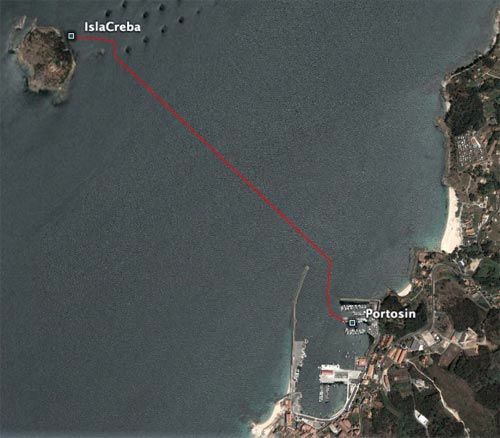
Portosin is a very modern and up to date with very northern prices. At €18.80 per day it is one of the most expensive we have visited on the trip (UK excluded). At checkin the staff were telling me how good the facilities were but they forgot to tell me that the hot water system was awaiting repair.
We were efficiently allocated a berth and were all fast by 10:40.
In the afternoon I caught a bus to Noia. This is another old trading town where the port has silted up.
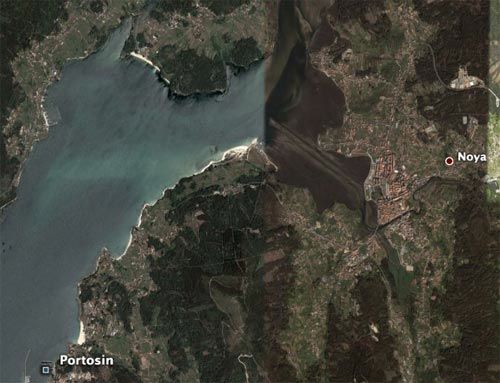
There are two training walls to divert water towards Noia but one would need a very shallow draught even at high tide. Even if a small shallow draught vessel managed to reach Noia there appears to be nowhere to get ashore.
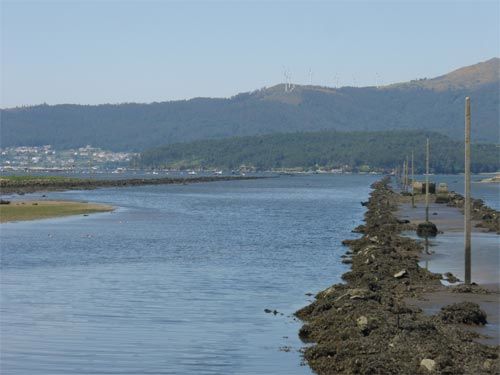
Noia has an attractive central plaza and an interesting old quarter again featuring a labyrinthe of stone paved narrow streets. I suspect it would be quite lively in the evenings given the number of bars and restaurants.
Town hall on the main plaza in Noia.
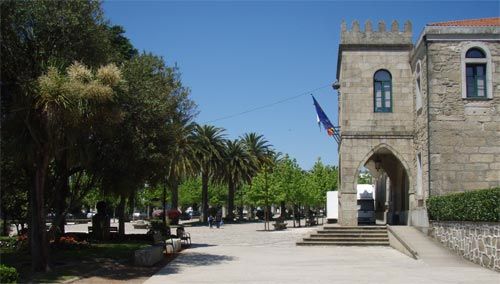
The further south we go the bigger the palms. Central plaza Noia.
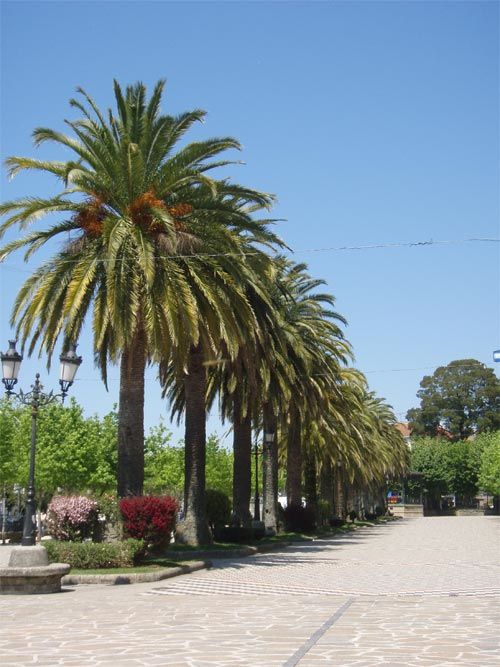
In many of the smaller Galician towns we have visited there have been buildings awaiting restoration.
A challenging example in the old quarter of Noia.
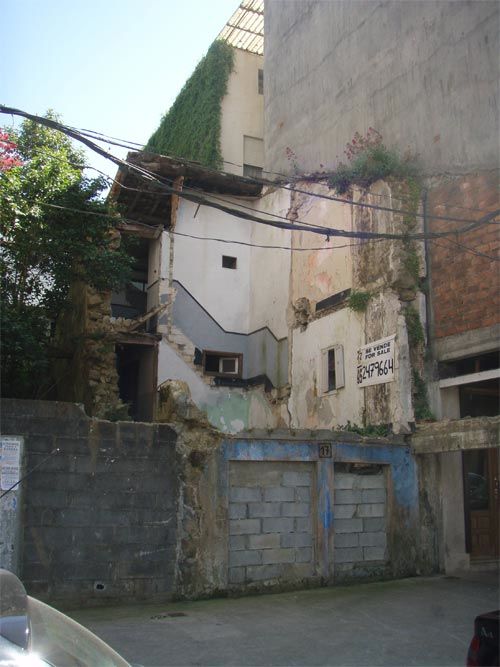
It is not far and at 0.81 miles must be our shortest day's run ever.

Portosin is a very modern and up to date with very northern prices. At €18.80 per day it is one of the most expensive we have visited on the trip (UK excluded). At checkin the staff were telling me how good the facilities were but they forgot to tell me that the hot water system was awaiting repair.
We were efficiently allocated a berth and were all fast by 10:40.
In the afternoon I caught a bus to Noia. This is another old trading town where the port has silted up.

There are two training walls to divert water towards Noia but one would need a very shallow draught even at high tide. Even if a small shallow draught vessel managed to reach Noia there appears to be nowhere to get ashore.

Noia has an attractive central plaza and an interesting old quarter again featuring a labyrinthe of stone paved narrow streets. I suspect it would be quite lively in the evenings given the number of bars and restaurants.
Town hall on the main plaza in Noia.

The further south we go the bigger the palms. Central plaza Noia.

In many of the smaller Galician towns we have visited there have been buildings awaiting restoration.
A challenging example in the old quarter of Noia.

Muros to Isla de Creba
08/May/2007 16:01 Filed in: Ria de Muros
A reasonably early start and went ashore for a coffee and another look around Muros. It really is a pretty little town.
Three more street scenes from Muros.
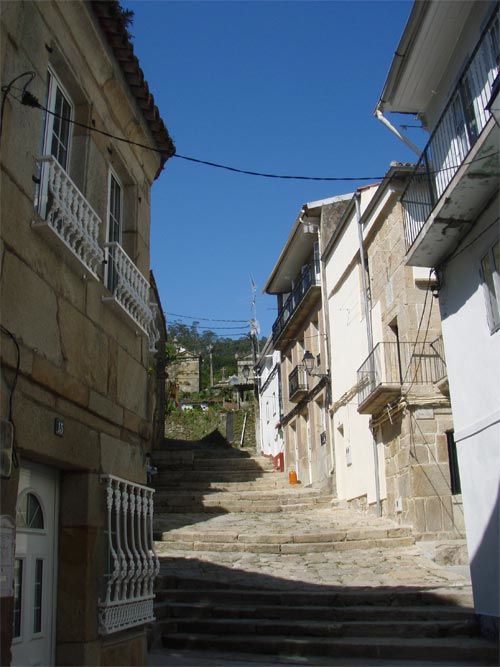
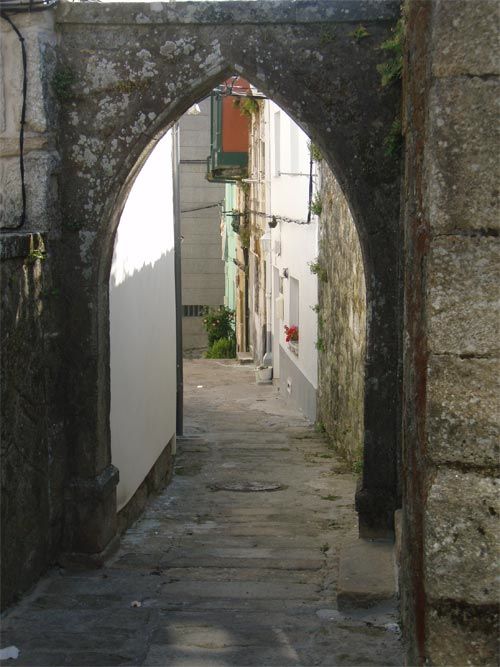
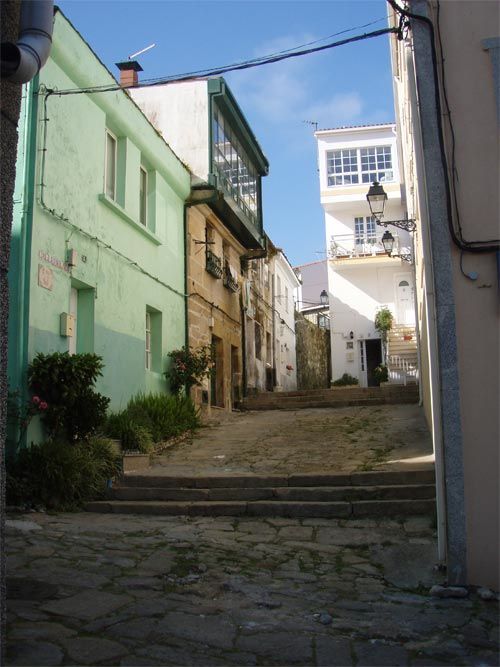
Then it was back on board for the trip to Isla de Creba.

Not one of our longer runs at 4.1 miles. Isla de Creba is privately owned, well tended and has a large house at the centre. There is at least one horse as well.
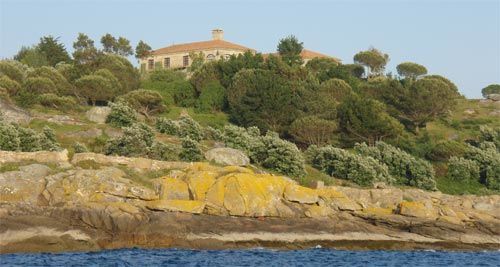
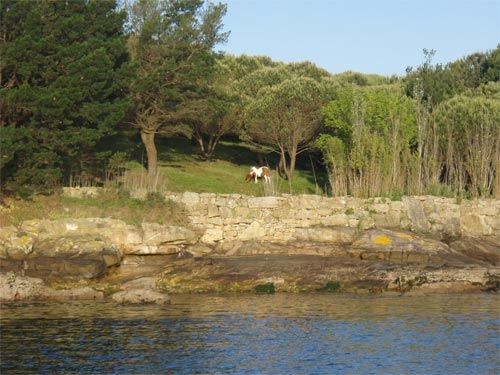
Our sheltered anchorage is off the NE corner of the island
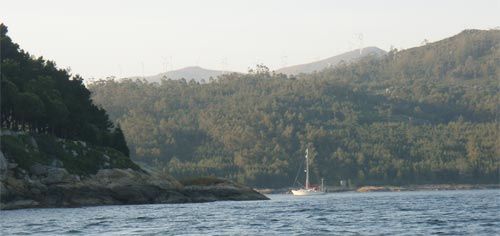
I spent an hour scrubbing some accumulated weed from Kiriwina's hull around the waterline then took Kiriwini to explore the shore for a while. I found a little beach to land and walked for a mile along the shore. Even up here there is solidified oil residue from "Prestige". It is a shame that this lovely coast gets a lot of rubbish washed in from the sea. The vast majority of it being plastic bottles. I could have collected hundreds in just a mile or so. A good case for all plastic bottles being sold with a refundable deposit.
Three more street scenes from Muros.



Then it was back on board for the trip to Isla de Creba.

Not one of our longer runs at 4.1 miles. Isla de Creba is privately owned, well tended and has a large house at the centre. There is at least one horse as well.


Our sheltered anchorage is off the NE corner of the island

I spent an hour scrubbing some accumulated weed from Kiriwina's hull around the waterline then took Kiriwini to explore the shore for a while. I found a little beach to land and walked for a mile along the shore. Even up here there is solidified oil residue from "Prestige". It is a shame that this lovely coast gets a lot of rubbish washed in from the sea. The vast majority of it being plastic bottles. I could have collected hundreds in just a mile or so. A good case for all plastic bottles being sold with a refundable deposit.
Playa de Estorde to Muros
07/May/2007 12:03 Filed in: Ria de Muros
I was woken at about 08:30 but the rattle of anchor chain as "Fruition" weighed anchor. She was returning north.
We got underway at 11:30 and proceed south, well off the coast to avoid numerous shoals and exposed rocks. At 14:00 we entered Ria Muros past a barren and rocky Monte Louro. The Ria is very deep and shelves rapidly very close to the shore. We anchored about 250 ft off Muros promenade at 15:00.
Kiriwini was deployed for a visit ashore. Muros is a lovely little fishing port but the promenade appears to be more tourist biased with many cafes and bars and some smart shops. The streets behind the promenade are a warren of stoned paved alleys with smallish houses many of which have been or are in the process of being restored.
Monte Louro on the northern shore at the entrance to Rio Muros with tiny lighthouse and off-lying rocks.
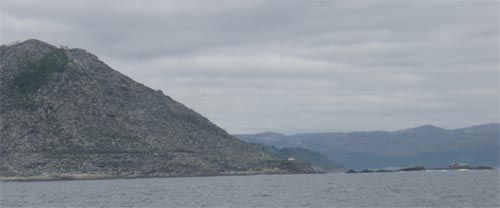
Approaching Muros with Punta Reconcido in the foreground.
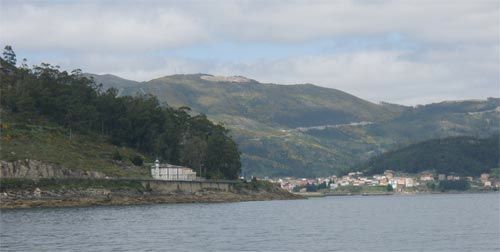
Muros Waterfront
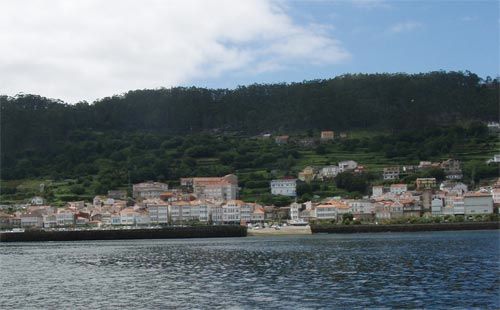
Ensenada de Muros looking NW
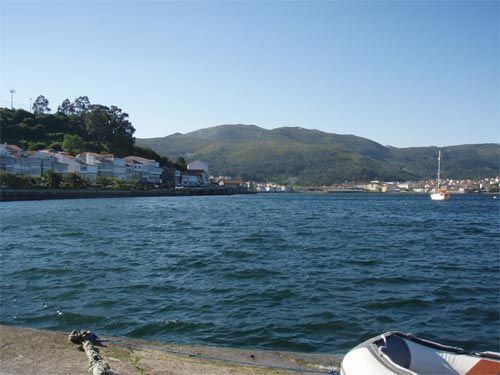
Muros promenade at 21:00

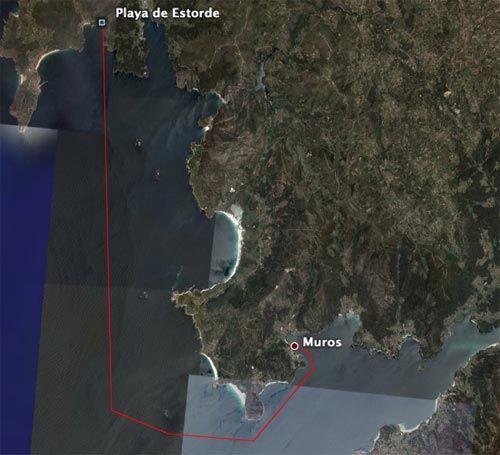
We got underway at 11:30 and proceed south, well off the coast to avoid numerous shoals and exposed rocks. At 14:00 we entered Ria Muros past a barren and rocky Monte Louro. The Ria is very deep and shelves rapidly very close to the shore. We anchored about 250 ft off Muros promenade at 15:00.
Kiriwini was deployed for a visit ashore. Muros is a lovely little fishing port but the promenade appears to be more tourist biased with many cafes and bars and some smart shops. The streets behind the promenade are a warren of stoned paved alleys with smallish houses many of which have been or are in the process of being restored.
Monte Louro on the northern shore at the entrance to Rio Muros with tiny lighthouse and off-lying rocks.

Approaching Muros with Punta Reconcido in the foreground.

Muros Waterfront

Ensenada de Muros looking NW

Muros promenade at 21:00


Camariñas to Playa de Estorde
06/May/2007 15:58 Filed in: Galicia
I had planned a reasonably early departure but was delayed by a morning fog. We sailed at 11:15 and made rapid progress down the coast under motor and main, helped by over a knot of southerly current. As usual there was very little until wind until around 14:00.
It was a lovely sunny day with the sea a deep turqoise blue. This was the last stretch of the Costa del Muerte. By the time we rounded Cabo Finisterre we had a northerly F4 which was not a lot of help as once round the cape we sailed a northerly course.
At 16:30 we anchored off Playa de Estorde which I had visited in April. I was surprised to see another boat in the anchorage. It was Dutch but I was unsure of the type. It looked like a restored fishing ketch and was in beautiful condition.
Approaching Cabo Finisterre from the north with the off-lying Sentolo de Finisterre visible.
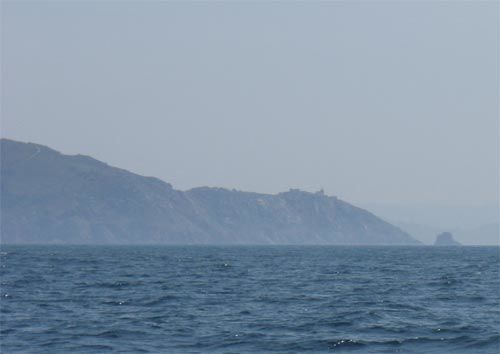
Seaward side of Cabo Finisterra.
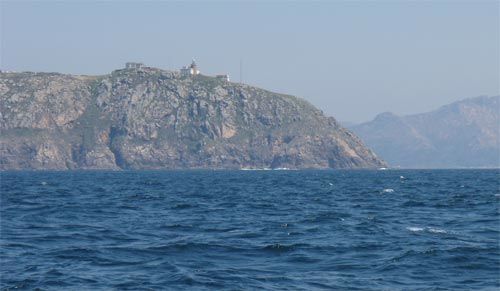
Another view from the south.
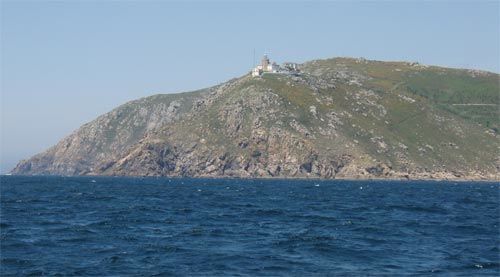
Playa de Estorde and the restaurant visited early in April.
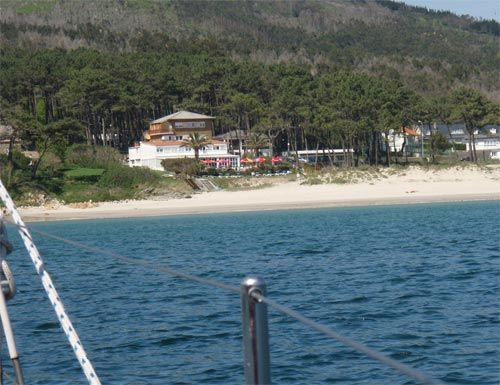
A view south west from Playa de Estorde with Cabo in the foreground and Cabo Finisterre in the background.
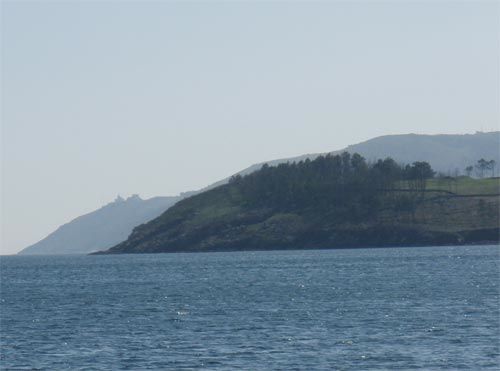
Kiriwina shared the anchorage with the Dutch vessel "Fruition"
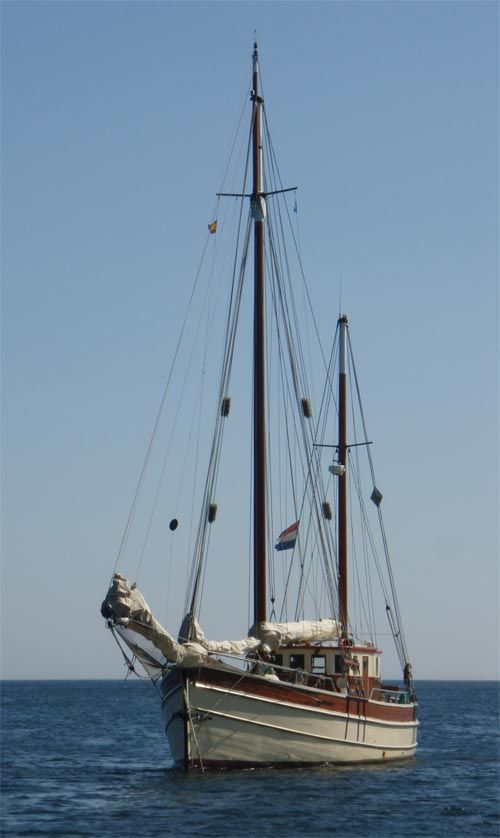
An attempt at a night shot with the Cabo Finisterre lighthouse on the right.
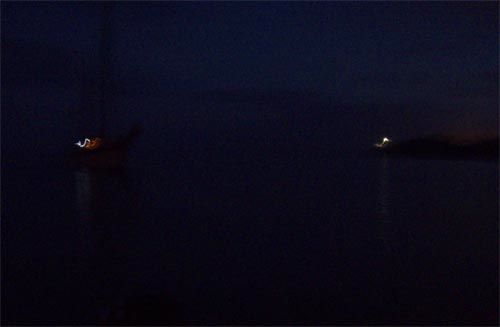
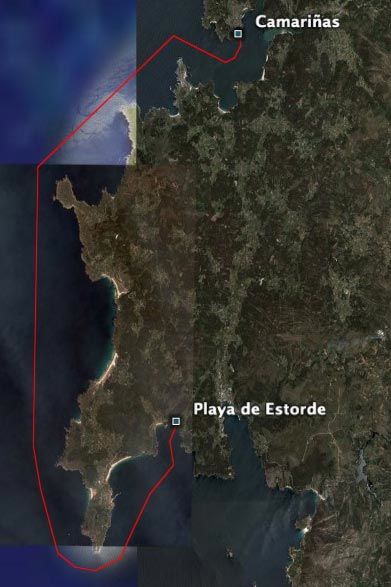
It was a lovely sunny day with the sea a deep turqoise blue. This was the last stretch of the Costa del Muerte. By the time we rounded Cabo Finisterre we had a northerly F4 which was not a lot of help as once round the cape we sailed a northerly course.
At 16:30 we anchored off Playa de Estorde which I had visited in April. I was surprised to see another boat in the anchorage. It was Dutch but I was unsure of the type. It looked like a restored fishing ketch and was in beautiful condition.
Approaching Cabo Finisterre from the north with the off-lying Sentolo de Finisterre visible.

Seaward side of Cabo Finisterra.

Another view from the south.

Playa de Estorde and the restaurant visited early in April.

A view south west from Playa de Estorde with Cabo in the foreground and Cabo Finisterre in the background.

Kiriwina shared the anchorage with the Dutch vessel "Fruition"

An attempt at a night shot with the Cabo Finisterre lighthouse on the right.


Camariñas and Puente del Puerto
05/May/2007 16:11 Filed in: Galicia
The pilot book mentions a little town further inland worth seeing. A visit involves a 9km walk or a much shorter row in the dinghy. I decided to walk.
The road follows the northern arm of the Ria around Ensenada de la Vasa and then cross country to Puente del Porto. On the outskirts of Camariñas large areas of woodland have been burnt out and new growth was just starting to appear on the trees. Bushfires swept through the area last summer.
It takes a little over two hours to reach Puente del Porto and it was worth the walk. A very pretty town whose main feature is the very old bridge. Originally a major port dating, it is said, from roman times where the fishing catch was landed and exports of timber and lace loaded. Now the river is silted up at the mouth and no longer navigable.
Allo, on the way to Puente del Porto.
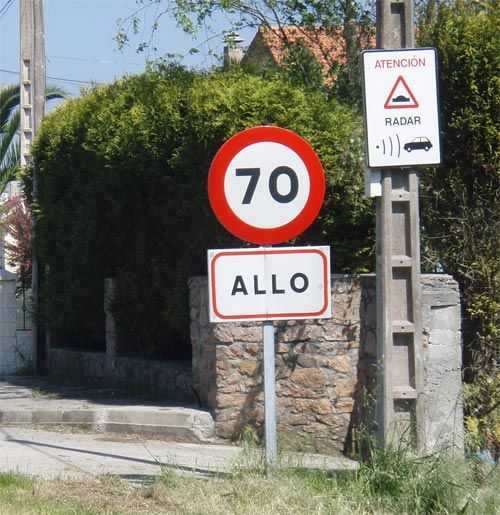
The bridge at Puente del Puerto.
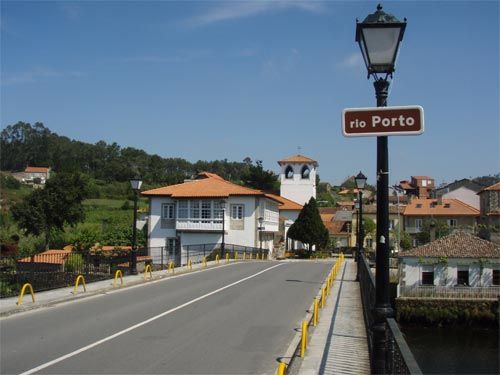
Downstream
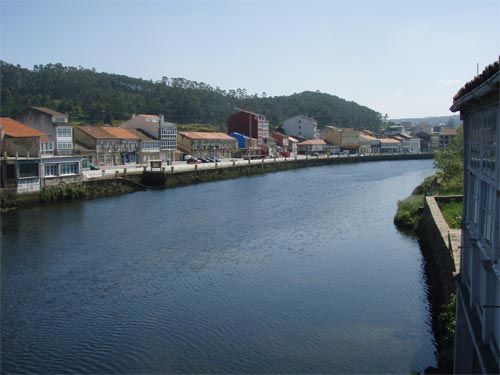
Upstream
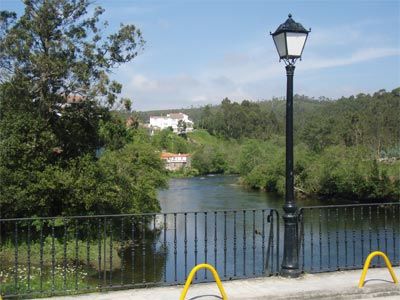
11th century church restored in 1953.
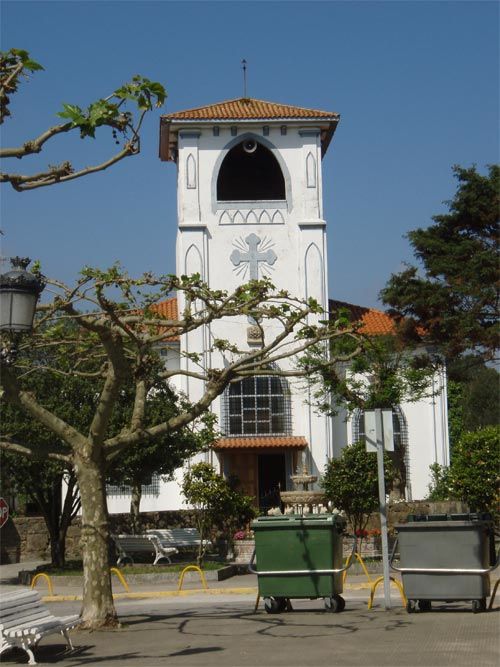
Small galleried buildings in Camariñas. One restored, one waiting...
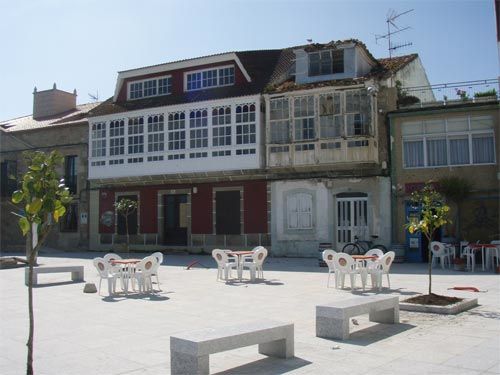
Waterfront at Camarñas looking north up the Ria.
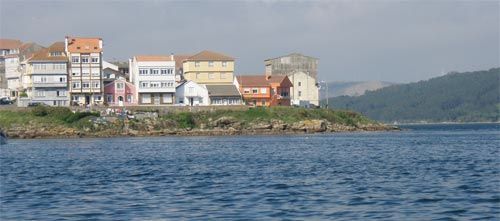
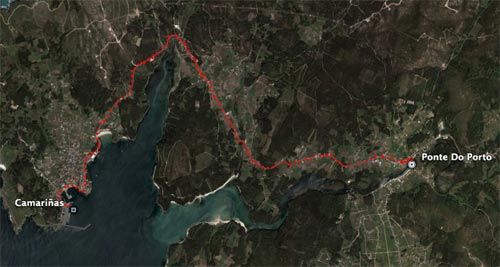
The road follows the northern arm of the Ria around Ensenada de la Vasa and then cross country to Puente del Porto. On the outskirts of Camariñas large areas of woodland have been burnt out and new growth was just starting to appear on the trees. Bushfires swept through the area last summer.
It takes a little over two hours to reach Puente del Porto and it was worth the walk. A very pretty town whose main feature is the very old bridge. Originally a major port dating, it is said, from roman times where the fishing catch was landed and exports of timber and lace loaded. Now the river is silted up at the mouth and no longer navigable.
Allo, on the way to Puente del Porto.

The bridge at Puente del Puerto.

Downstream

Upstream

11th century church restored in 1953.

Small galleried buildings in Camariñas. One restored, one waiting...

Waterfront at Camarñas looking north up the Ria.


Corme to Camariñas
04/May/2007 13:43 Filed in: Galicia
No great hurry to leave today. I've noticed that the mornings are relatively calm and is often well after lunch before the wind blows in any strength.
We cleared Corme harbour at 11:40 and proceeded under motor and main. The sea is again almost calm with a NW swell. It is also very hazy though not foggy. At 13:30 the wind has started to blow from the north so I turn the engine off. Our speed drops to 2.7 knots under main alone but when the yankee was deployed we were doing 4.2 knots. Steering is handed over to Dame Kiri (our Aries windvane) and we then sail all the way into Camariñas harbour.
This is the coast I toured in November. We sailed past the tiny port of Puerta Marina, barely visible from the sea in amongst the rocky approaches. Then we were off the shoals where the "HMS Serpent" was wrecked. A truly awesome coast.
We passed Cabo Villano lighthouse, built in 1896 and the first in Spain to use electricity, at 14:30.
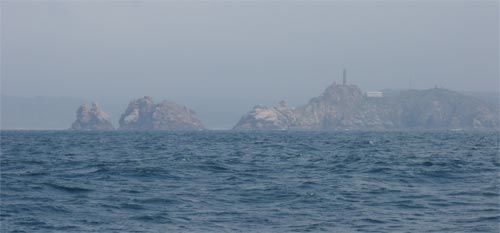
The wind increased once we got round Cabo Villano and we sailed towards the Ria Camariñas entrance at over 5 knots.
A church on Punta de la Barca on the south side of the entrance.
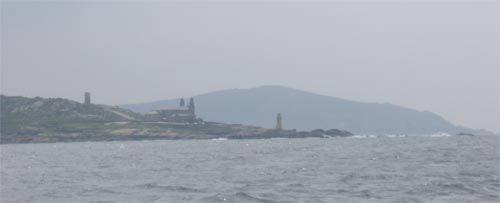
At 16:00 when we dropped the sails a northerly wind was blowing down the Ria at over 20k. We moored on the centre pontoon at Club Nautico do Camariñas.
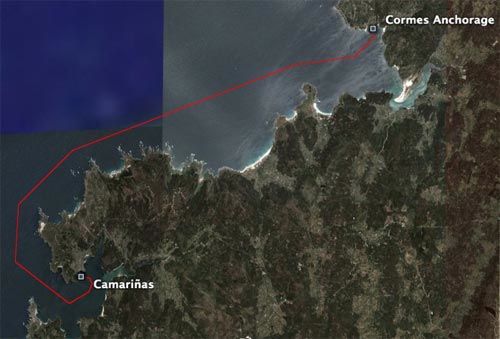
We cleared Corme harbour at 11:40 and proceeded under motor and main. The sea is again almost calm with a NW swell. It is also very hazy though not foggy. At 13:30 the wind has started to blow from the north so I turn the engine off. Our speed drops to 2.7 knots under main alone but when the yankee was deployed we were doing 4.2 knots. Steering is handed over to Dame Kiri (our Aries windvane) and we then sail all the way into Camariñas harbour.
This is the coast I toured in November. We sailed past the tiny port of Puerta Marina, barely visible from the sea in amongst the rocky approaches. Then we were off the shoals where the "HMS Serpent" was wrecked. A truly awesome coast.
We passed Cabo Villano lighthouse, built in 1896 and the first in Spain to use electricity, at 14:30.

The wind increased once we got round Cabo Villano and we sailed towards the Ria Camariñas entrance at over 5 knots.
A church on Punta de la Barca on the south side of the entrance.

At 16:00 when we dropped the sails a northerly wind was blowing down the Ria at over 20k. We moored on the centre pontoon at Club Nautico do Camariñas.

Ares to Corme
03/May/2007 15:37 Filed in: Galicia
Up early and away at just after 08:00. There is not much wind but I put the main up anyway and motor sail.
On the way out of the Ria we pass the Medi Baltimore with the Torre de Hercules visible just to the left of her bow.
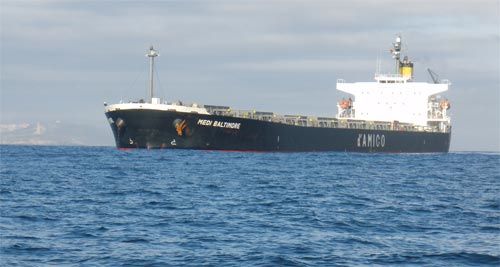
A little later we pass the Torre de Hercules and la Coruña and are moving south again. Must confess to being a little sad leaving la Coruña behind after a very enjoyable stay. There are two yachts ahead of us and they fade into the distance.
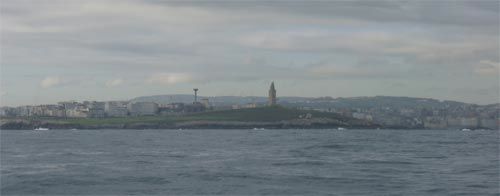
The sea is almost calm with a moderate NW swell. At around 14:00 we pass the Islas Sisargas near Malpica. It is quite hazy.
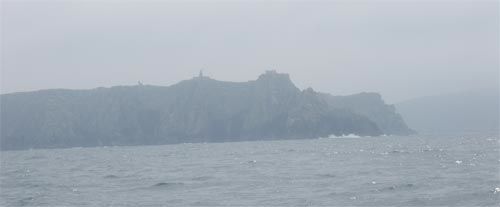
Once round the Islas I put the yankee up but we are still motor sailing. For several hours we had company in the form of a Dutch Bavaria 37, 'King Alexander" from Lelystad. She gradually overtook us then we passed her and finally she overtook us again.

At 15:00 we are approaching Punta del Rocundo which I visited during my road trip in November. The benign conditions disguise what a harsh and vicious coast this is. The off lying rocks are barely visible.
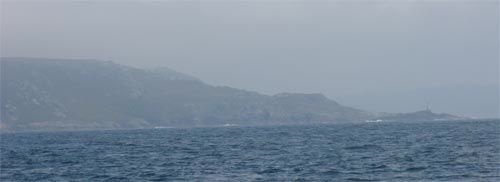
A closer view of breaking shoals near Cabo Rocundo.
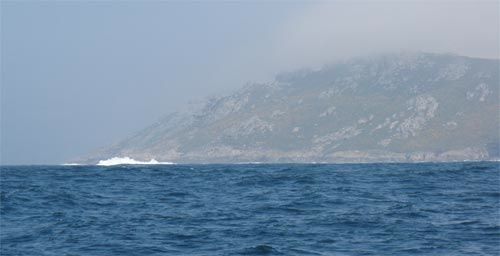
An hour later we have entered the Ria de Corme y Lage. There is a brisk northerly blowing and a decision needs to be made. Do we go to Corme in the north or Lage in the south. Given the prevailing conditions I choose Corme. A smaller town but better shelter.
As we approach Corme it is obvious that there is a large Riviero (mussel farm) off the harbour. This is not shown on my charts or in the pilot book but is shown on my electronic chart. We anchor off Playa de la Arnela in Corme harbour at 17:00. Day's run 37 miles, all motor sailing.
Kiriwina at anchor in Corme harbour. The town of Lage on the other side of the Ria is visible in the background.
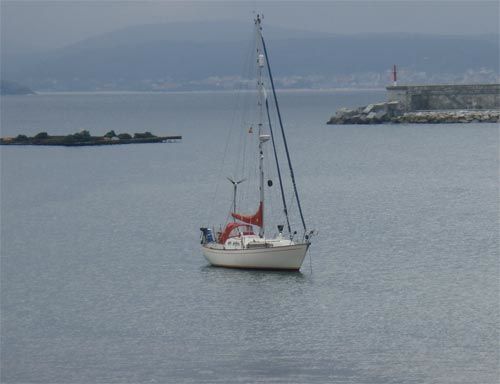
Corme is a small town but I decided to go ashore and have a look around. When I row the tender over to the nearest landing the residual swell in the harbour means that a wet landing would be highly likely. Instead I rowed over to the harbour wall and climbed up a ladder.
Corme is not small it is very small. Quite a pretty place with a few shops and bars but in half an hour I think I have pretty well seen the town.
Waterfront at Corme
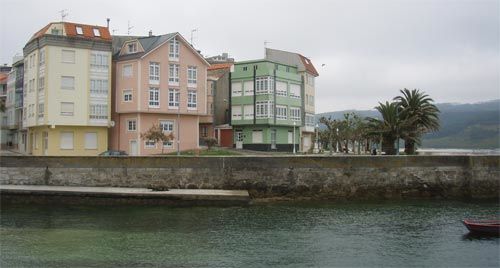
There are three beaches close to the town. The photo shows the third in the background behind Kiriwina.
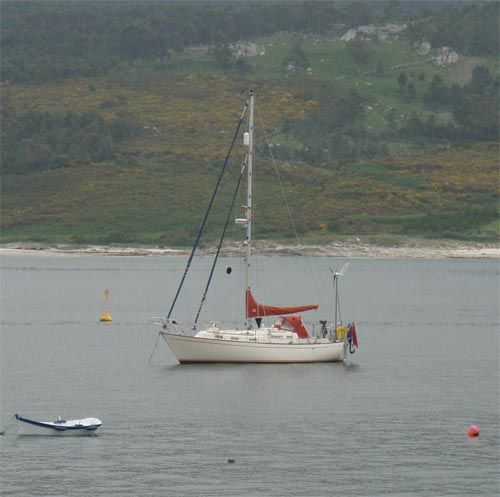
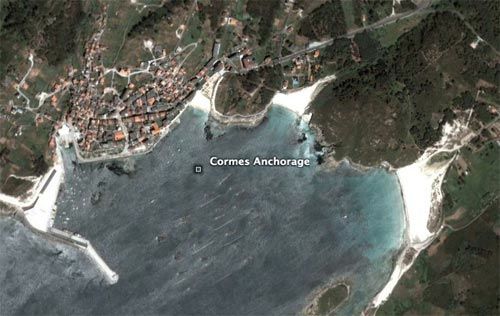
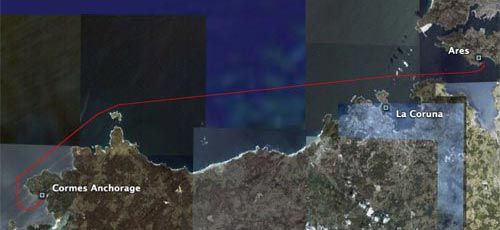
On the way out of the Ria we pass the Medi Baltimore with the Torre de Hercules visible just to the left of her bow.

A little later we pass the Torre de Hercules and la Coruña and are moving south again. Must confess to being a little sad leaving la Coruña behind after a very enjoyable stay. There are two yachts ahead of us and they fade into the distance.

The sea is almost calm with a moderate NW swell. At around 14:00 we pass the Islas Sisargas near Malpica. It is quite hazy.

Once round the Islas I put the yankee up but we are still motor sailing. For several hours we had company in the form of a Dutch Bavaria 37, 'King Alexander" from Lelystad. She gradually overtook us then we passed her and finally she overtook us again.

At 15:00 we are approaching Punta del Rocundo which I visited during my road trip in November. The benign conditions disguise what a harsh and vicious coast this is. The off lying rocks are barely visible.

A closer view of breaking shoals near Cabo Rocundo.

An hour later we have entered the Ria de Corme y Lage. There is a brisk northerly blowing and a decision needs to be made. Do we go to Corme in the north or Lage in the south. Given the prevailing conditions I choose Corme. A smaller town but better shelter.
As we approach Corme it is obvious that there is a large Riviero (mussel farm) off the harbour. This is not shown on my charts or in the pilot book but is shown on my electronic chart. We anchor off Playa de la Arnela in Corme harbour at 17:00. Day's run 37 miles, all motor sailing.
Kiriwina at anchor in Corme harbour. The town of Lage on the other side of the Ria is visible in the background.

Corme is a small town but I decided to go ashore and have a look around. When I row the tender over to the nearest landing the residual swell in the harbour means that a wet landing would be highly likely. Instead I rowed over to the harbour wall and climbed up a ladder.
Corme is not small it is very small. Quite a pretty place with a few shops and bars but in half an hour I think I have pretty well seen the town.
Waterfront at Corme

There are three beaches close to the town. The photo shows the third in the background behind Kiriwina.



